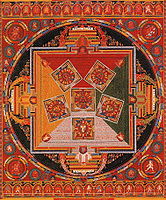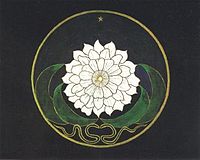- 분류 전체보기 (3178)

| 일 | 월 | 화 | 수 | 목 | 금 | 토 |
|---|---|---|---|---|---|---|
| 1 | 2 | 3 | 4 | 5 | ||
| 6 | 7 | 8 | 9 | 10 | 11 | 12 |
| 13 | 14 | 15 | 16 | 17 | 18 | 19 |
| 20 | 21 | 22 | 23 | 24 | 25 | 26 |
| 27 | 28 | 29 | 30 |
- 종경록
- 유가사지론
- 대방광불화엄경
- 유마경
- 아미타불
- 대방광불화엄경60권본
- 백유경
- 마하반야바라밀경
- 방광반야경
- 묘법연화경
- 대지도론
- 중아함경
- 금강삼매경론
- 수능엄경
- 무량의경
- 대승기신론
- 장아함경
- 증일아함경
- 정법화경
- 원각경
- 반야심경
- 대반열반경
- 마하승기율
- 가섭결경
- 잡아함경
- Japan
- 마명
- 대반야바라밀다경
- 근본설일체유부비나야
- 유마힐소설경
- Since
- 2551.04.04 00:39
- ™The Realization of The Good & The Right In Wisdom & Nirvāṇa Happiness, 善現智福
- ॐ मणि पद्मे हूँ
불교진리와실천
만다라 본문
【만다라
[한문]曼陀羅
[범어]māndāra ; mandārava
[티벳]man da ra ba
[영어]mandara】
【동음이어】-2
만다라
[한문]曼茶羅
[범어]maṇḍala
[티벳]dkyil ’khor
[영어]circle ; the practical or ritual realm ; symbolic paintings ; the diagrammatical symbol
【동음이어】-1
만다라
[한문]曼陀羅 [범어]māndāra ; mandārava [티벳]man da ra ba [영어]mandara
원어인 만다라,
또는 만다라바의 음역.
曼茶羅라고도 함.
매우 아름다운 빛깔을 지닌 천상의 꽃으로서,
보는 이에게 큰 기쁨을 준다고 함.
나무 모양은 파리질다수(波利質多樹)와 같아서,
그 잎이 매우 많다고 함.
[동]만다륵(曼陀勒) , 만나라(曼那羅) , 만다라범(曼陀羅梵) , 천묘(天妙) , 열의(悅意) , 적의(適意) , 잡색(雜色).
● From 고려대장경연구소 불교사전
【동음이어】-2
만다라
[한문]曼茶羅 [범어]maṇḍala [티벳]dkyil ’khor [영어]circle ; the practical or ritual realm ; symbolic paintings ; the diagrammatical symbol
만달라의 음역.
滿茶邏,
蔓陀囉라고도 함.
[동]만나라(曼拏羅) , 만나(曼拏) , 만다(曼茶) , 취집(聚集).
[1]석가모니가 성도할 당시에 앉아 있었던 보리수 아래의 금강좌.
또는 금강좌를 중심으로 한 구역을 가리키는 말.
[동]보리도량(菩提道場) , 도량(道場).
[2]원형이나 방형으로 일정한 구획을 지어서 경계를 삼는 것.
어떤 의식(儀式)이나 비법(秘法)을 위해서,
또는 부정이나 악귀를 방지할 목적으로 경계를 표시하여 구분 지어 놓은 것.
[동]단(壇) , 윤원구족(輪圓具足).
[3]불교적 우주관을 도상으로 표현한 것.
불보살들의 세계와 그 구조를 신비로운 도형으로 나타낸 것을 말하며,
특히 밀교에서 중요시되는 수행 도구의 하나이다.
만다라는 일찍이 고대 인도에서부터 그려져 왔으나
특히 밀교에서 관상법(觀想法)의 도구로 채용한 뒤
다양한 종류와 모양으로 제작되어 불화를 대표하는 그림 양식이 되었다.
그 주제에 따라 두 종류로 나뉜다.
첫째, 석가모니의 본생 설화를 주제로 그린 그림.
둘째, 대승 경전의 내용을 토대로 한 다양한 회화적 표현물 등.
[동]
변상도(變相圖).
● From 고려대장경연구소 불교사전
【동음이어】-2
만다라
[한문]曼茶羅
【범】maṇḍala
또는 만다라(滿茶羅)ㆍ만타라(曼陀羅).
구역(舊譯)에서는 단(壇)ㆍ도장(道場),
신역(新譯)에서는 윤원구족(輪圓具足)이라 번역.
단(壇)은 평탄하다는 뜻.
본디는 인도의 옛 풍습으로 일정한 땅을 구획하여 평탄하게 단을 만들어,
여러 불ㆍ보살을 모시고 예배ㆍ공양하던 것이므로
단(壇)이라 번역.
윤원구족은 뜻 번역으로,
낱낱 살(輻)이 속바퀴(轂)로 모여
둥근 수레바퀴(圓輪)를 이루는 것과 같이,
모든 법을 다 원만하게 갖추어 결함이 없다는 뜻.
밀교에서는 주로 뒤의 뜻으로 쓴다.
여기에 두 가지 뜻이 있다.
넓은 뜻으로
만다라에는 만덕장엄(萬德莊嚴)ㆍ능생(能生)ㆍ적집(積集)의 세 가지 뜻이 있어
우주의 삼라만상이 모두 만다라 아닌 것이 없다는 것이고,
좁은 뜻으로
한 곳에 여러 불ㆍ보살을 줄지어 모신 것을 말한다.
여기에 금강계 만다라ㆍ태장계 만다라가 있다.
이것은 현도(現圖) 만다라로서
아사리(阿闍梨) 소전(所傳)의 만다라와
4종 만다라 등이 있으며,
또 극락 정토의 모양을 그린 정토 변상(變相)을 세속에서
정토 만다라라고 한다.
● From 운허 동국역경원 불교사전
❋추가참조
◎[개별논의]
○ [pt op tr]

○ 2019_1104_161534_can_AR35_s12 구례 쌍계부근

○ 2018_1023_122037_can_Ar12 예산 덕숭산 수덕사

○ 2020_1017_173902_can_BW17 삼각산 화계사

○ 2020_1017_151836_can_CT28 삼각산 화계사

○ 2020_1002_122809_nik_ar37 파주 고령산 보광사

○ 2020_0930_145611_nik_BW3 화성 용주사

○ 2020_0905_121552_can_BW28 오대산 월정사

○ 2020_0905_111607_can_BW17 오대산 월정사

○ 2020_0904_092836_nik_ar47 여주 신륵사

○ 2019_1201_154622_nik_BW25 원주 구룡사

○ 2019_1105_160010_can_bw24 순천 조계산 송광사

○ 2019_1105_124752_can_ar38 순천 조계산 선암사

○ 2019_1106_154428_can_ct30 화순 계당산 쌍봉사

○ 2019_1106_154327_can_ct19_s12 화순 계당산 쌍봉사

○ 2019_1106_101536_can_ar2_s12 화순 영구산 운주사
● [pt op tr] fr

○ 2020_1017_152233_can_Ar37 삼각산 화계사

○ 2020_0910_115148_nik_CT33 속리산 법주사
추가불교사전 참조사항
❋❋추가참조 ♥ ◎[개별논의]
○ [pt op tr]
● From 한국위키 https://ko.wikipedia.org/wiki/
취집은 여기로 연결됩니다.
다른 뜻에 대해서는 하이퍼가미 문서를 참조하십시오.
>>>
만다라
만다라(曼茶羅, 曼陀羅, 산스크리트어: मण्डल, मंडल Maṇḍala, 원, 완료, 영어: Mandala)는 다양한 개체를 지칭하는 용어이다.
"만다라"라는 낱말 자체는 "원(圓 · circle)"을 뜻하는
산스크리트어 만달라(मण्डल Maṇḍala)를 음을 따라 번역한 것이다.
만다라는 원래는 힌두교에서 생겨난 것이지만 불교에서도 사용된다.
주로, 힌두교의 밀교(탄트리즘 · Tantrism)와
불교의 밀교(금강승 · Vajrayana)의 종교적 수행 시에
수행을 보조하는 용도로 사용하는,
정해진 양식 또는 규범에 따라 그려진 도형을 가리킨다.
힌두교의 얀트라(यन्त्र · Yantra)도 이러한 도형에 해당하는데
만다라의 일종이라 생각할 수 있다.
보통 "얀트라"라는 낱말은
만다라와는 구분하여 힌두교의 문맥에서만 사용되는데,
반면 "만다라"라는 낱말은 힌두교와 불교 모두에서 사용된다.
힌두교와 불교의 전통에서, 만다라의 기본 형태는
사각형의 중심에 원이 있으며
사각형의 각 변의 중앙에 한 개의 문이 있는 형태로,
이 때 각 문은 주로 영어의 티(T)자 모양을 한다.[1][2]
(오른쪽에 있는 불교의 금강계 만다라와
힌두교의 스리 얀트라 그림을 참조하시오.)
한문으로 번역된 불교의 밀교 경전에서,
당나라의 현장(玄奘: 602~664) 이전의 번역인 구역(舊譯)에서는
만다라(曼茶羅)를 단(壇)이라고 한역(漢譯)하였다.[3]
반면 당나라 현장 이후의 번역인 신역(新譯)에서는
취집(聚集)이라고 한역하였다.[3]
한편, 만다라를 윤원구족(輪圓具足)이라 번역하기도 한다.[4]
한편, 불교에서,
만다라 꽃은
연화(蓮花: 연꽃)를 가리키며
불상(佛像) 앞에 놓인 제단을 만다라라고도 한다.
금강승(바즈라야나) 계열의 티베트 불교에서는
모래그림(sandpainting)을 사용하여 만다라를 제작하는 방법도 개발하였다.
이들을 모래 만다라(Sand-mandala)라고 한다.
■ 목차
1불교의 만다라1.1태장계 만다라
1.2금강계 만다라
2갤러리
3각주
4참고 문헌
불교의 만다라[편집]
불교의 밀교에서는 다라니(陀羅尼)를 암송하는 것을 통해 마음을 통일시키는 수행과
여러 부처와 보살에 대한 공양(참고: 염불)이 강조되었는데,
사각형 또는 원형의 흙으로 만든 단(壇)을 만들어
여기에 불상과 보살상을 둔 후
수행 의식을 행하고 공양을 올렸다.[3]
이 단(壇)을 만다라라고 하였는데,
또한 여러 부처와 보살이 충만되어 있는 곳이라는 의미에서
취집(聚集)이라고도 하였다.[3]
산스크리트어 "만달라(मण्डल Maṇḍala)"는
원래는 본질을 뜻하는 만달(Maṇḍal)과
소유를 뜻하는 라(la)가 결합되어 이루어진 낱말로,
"본질의 것", "본질을 소유한 것", 또는 "본질을 담고 있는 것"이라는 의미를 가지고 있다.[3][4]
이런 의미에서는, 불교의 본질은
보리(菩提), 즉 깨달음이기 때문에
만다라는 부처의 깨달음의 경지(境地)를 상징화하여
신성(神聖)한 단(壇)이라는 물리적 · 입체적 형태로 표현한 것이라 할 수 있다.[3]
중국 · 티베트 등의 불교 중 밀교에서는 대일여래(大日如來)를 중심으로 하여
여러 부처와 보살을 배치한 그림을 가리켜 만다라고도 한다.[3]
이러한 그림으로서의 만다라도,
다만 도형화하여 평면적으로 표현되었다는 점을 제외하고는,
부처의 깨달음의 경지를 상징화하여 표현했다는 점에서는
입체적인 단(壇)과 본질적인 의미가 동일하다.
이런 면에서, 만다라는 수행자가 명상을 통하여
우주의 에센스("불성")와 합일하고자 할 때 사용하는
깨달음의 안내도라는 의미가 있다.
불교의 밀교에서는
깨달음의 경지를 도형화한 만다라를
윤원구족(輪圓具足)이라고 번역하기도 한다.[4]
윤원구족은 낱낱의 살(輻)이 바퀴축(轂)에 모여
둥근 수레바퀴(圓輪)를 이루듯이,
모든 법을 원만히 다 갖추어 모자람이 없다는 것을 뜻한다.[4]
태장계 만다라[편집]
태장계 만다라:
가운데에 여덟 개의 연꽃 잎이 있는 원이 있는데
이 원의 중심부에 대일여래가 있으며
각 연꽃 잎에도 한 명의 부처 또는 보살이 있다
《대일경(大日經)》은 7세기 후반에 인도 중부에서 성립되었는데,
여러 부처와 보살을 대일여래를 중심으로 집대성하여
만다라로 표현하고 있으며
이 만다라를 태장계 만다라(胎藏界曼茶羅 · Garbhadhatu mandala)라고 하였다.[3]
태장계 만다라를 사용하는 태장계 밀교는
이론적으로 《화엄경(華嚴經)》에 나타난 사사무애법계(事事無礙法界)의 교의를 받아들여
현실의 사상(事象)에서
곧바로 우주의 진실상(眞實相)을 직관(直觀)할 것을 주장한다.[3]
금강계 만다라[편집]
금강계 만다라(Vajradhatu Mandala)가 그려져 있는 티베트 불교의 탕카
《대일경(大日經)》이 성립된 때로부터
얼마 후에 인도 남부에서 성립되었다고 하는 《금강정경(金剛頂經)》은
유가행파의 교의에 의거하여 만들어진
금강계 만다라(金剛界曼茶羅 · Vajradhatu Mandala)에 대한 내용을 담고 있다.[3]
금강계 만다라를 사용하는 밀교를
금강계 밀교라고도 한다.
갤러리[편집]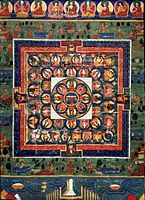
부탄의 약사여래 만다라, 19세기
여섯 전륜성왕(Chakravartin)의 만다라
금강해모(金剛亥母 · Vajravarahi) 만다라
■■.■----------------------- 
힌두교의 스리 얀트라(Sri Yantra)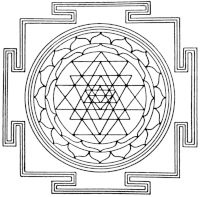
스리 얀트라(Sri Yantra)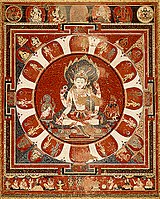
비슈누 만다라
나로빠(Naropa) 전통의 만다라, 19세기
자이나교의 우주론을 보여주는 그림과 문헌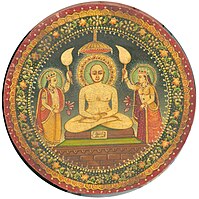
마하비라
칼 융의 환자가 그린 만다라
위키미디어 공용에 관련된 미디어 자료와 분류가 있습니다.만다라 (분류)
각주[편집]
↑ (영어) Artiste Nomade, "만다라란 무엇인가(What's a mandala)?" Archived 2010년 11월 19일 - 웨이백 머신. 2011년 3월 27일에 확인.
↑ (영어) Kheper, "신성한 기하학이자 미술로서의 불교의 만다라(The Buddhist Mandala - Sacred Geometry and Art)". 2011년 3월 27일에 확인.
↑ 이동:가 나 다 라 마 바 사 아 자 차 종교·철학 > 세계의 종교 > 불 교 > 불교의 사상 > 밀교의 사상 > 만다라, 《글로벌 세계 대백과사전》
↑ 이동:가 나 다 라 "만다라 mandala, 曼茶(陀)羅, 윤원구족"[깨진 링크(과거 내용 찾기)], 《네이버 백과사전》. 2011년 3월 17일에 확인.
참고 문헌[편집]![]()
![]() 이 문서에는 다음커뮤니케이션(현 카카오)에서 GFDL 또는 CC-SA 라이선스로 배포한 글로벌 세계대백과사전의 내용을 기초로 작성된 글이 포함되어 있습니다.
이 문서에는 다음커뮤니케이션(현 카카오)에서 GFDL 또는 CC-SA 라이선스로 배포한 글로벌 세계대백과사전의 내용을 기초로 작성된 글이 포함되어 있습니다.
둘러보기로 가기검색하러 가기![]() 취집은 여기로 연결됩니다. 다른 뜻에 대해서는 하이퍼가미 문서를 참조하십시오.
취집은 여기로 연결됩니다. 다른 뜻에 대해서는 하이퍼가미 문서를 참조하십시오.![]() 영화에 대해서는 만다라 (영화) 문서를 참조하십시오.
영화에 대해서는 만다라 (영화) 문서를 참조하십시오.
| 상위분류 | 금강승불교 |  |
|---|---|---|
| 시대・지역 | 초기밀교 중기밀교 후기밀교 인도밀교 중국밀교 일본밀교 |
|
| 종파 | 동밀(고의진언종계): 고야산진언종※ 동사진언종※ 진언종선통사파※ 진언종제호파※ 진언종어실파※ 진언종대각사파※ 진언종천용사파※ 진언종산계파※ 신귀산진언종※ 진언종중산사파※ 진언삼보종※ 진언종수마사파※ 진언동동사파 동밀(신의진언종계): 신의진언종※ 진언종지산파※ 진언종풍산파※ 진언종실생사파 진언률 진언률종※ 태밀(천태종계): 일본 천태종 (「※」는 진언종각산회 가입단체) |
|
| 신앙대상 | 여래 보살 명왕 천 |
|
| 사상・교리 | 즉신성불 삼밀 입아아입 만다라 호마 |
|
| 경전 | 『대일경』 『금강정경』 『소실지경』 『이취경』 |
>>>
● From 위키영문 https://en.wikipedia.org/wiki/maṇḍala
영문위키 <with 파파고번역기>
만다라
무료 백과사전인 위키피디아에서
Jump to navigationJump to search다른 용도에 대해서는 Mandala(분리)를 참조하십시오.
만칼라와 혼동하지 마세요.
만주바라 만달라의 관가화
만다라(첫번째 음절 강조, 산스크리트어 Sanskritल, mamaṇala-문자 그대로"원")는 매우 다른 어플리케이션을 가진 기호의 기하학적 구성입니다. 다양한 영적 전통에서, 만다라는 영적인 지도 도구로서 개업의와 adept의 주의를 집중시키고, 신성한 공간을 만들고 명상과 최면에 대한 도움으로써 사용될 수 있습니다. 동양의 힌두교, 불교, 자이니즘, 신토교에서 그것은 신을 대표하는 지도로 사용되며 특히 신토교, 파라디스, 가미 또는 실제 사당으로 사용된다[1][2].
새로운 시대에, 만다라는 기하학적으로 또는 상징적으로 우주를 나타내는 다이어그램, 차트 또는 기하학적 패턴이다;우주의 시간 마이크로초, 원래 그것은 전체를 나타내고 생명의 조직 구조를 위한 모델을 나타내는 것을 의미했다, 그것은 무한하고 확장된 세상과의 관계를 보여 주는 우주 다이어그램이다. 마음과 몸을 넘어서
내용물
1힌두교1.1종교적 의미
1.2정치적 의미
2불교2.1Vajrayana2.1.1금강 역사의 시각화2.1.1.1메루 산
2.1.1.2지혜와 성급함
2.1.1.3오불상
2.1.2연습
2.1.3과
2.2신곤 불교
2.3니치렌 불교
2.4순수 토지 불교
3메소포타미아 문명3.1마야 철진
3.2아즈텍 선 스톤
4기독교
5페르시아 미술의 만달라스
6서양의 심리학적 해석
7고고학에 있어서
8건축에서
9과학에서
10현대에 있어서.
11갤러리
12참고 항목
13참조
14원천
15추가적인 읽기
16외부 링크
힌두교[편집]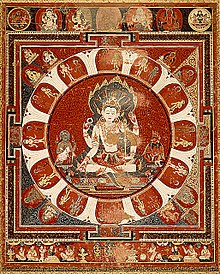
만다라
■ 종교적 의미[편집]
힌두교 만다라의 기본 형태는 중앙점을 가진 원을 포함하는 4개의 문이 있는 정사각형이며, 그것은 또한 얀트라라고도 불린다. 각각의 게이트는 보통 [3]T.Mandalas의 모양으로 되어 있다. 종종 방사형 균형을 가지고 있다[4].
얀트라는 만다라와 유사하며, 보통 더 작고 더 제한된 색 팔레트를 사용합니다. 그것은 사흐라나, 푸자 또는 명상 의식에 사용되는 2차원 또는 3차원 기하학적 구조일 수 있고, 그것의 디자인에 주문을 포함시킬 수도 있다. 그것은 신의 거처로 여겨진다. 각각의 얀트라는 독특하고 정교한 상징적인 기하학적 디자인을 통해 신을 실무자의 존재로 부른다. 한 학자에 따르면,"옌트라스는 우주적 진리의 계시적인 상징으로서, 그리고 인간 경험의 영적인 측면에 대한 교육 차트로서 기능한다.[5]"
많은 사람들이 힌두교의 탄트리 연습의 중심점으로 고구마를 먹는다. 얀트라스는 표현이 아니라 경험적이고 평범한 현실로 살고 있다. Khanna는 다음과 같이 설명합니다.
그것의 우주적 의미에도 불구하고 얀트라는 현실에 살고 있다. 바깥 세상(거시 세계)과 인간의 내면 세계(축소판)사이에 존재하는 탄트라스에 존재하는 관계 때문에, 양트라의 모든 상징은 내부-외부 합성에서 절묘하게 공명하며 인간 의식의 미묘한 신체와 측면과 관련이 있다[6].
■ 정치적 의미[편집]
주요 기사:만다라(정치 모델), 대 인도, 인도
라자만달라는 인도 작가 카우틸야가 4세기 BC와 2세기 BC사이에 쓰여진 아르타사하스트라라는 정치에 관한 연구에서 공식화했다. 이 책은 왕의 국가를 둘러싸고 있는 우호적이고 적대적인 국가들을 묘사하고 있다[7].
역사적, 사회적, 정치적 의미에서 "만다라"라는 용어는 전통적인 동남 아시아의 정치적 형성을 나타내기 위해서도 사용된다. 그것은 전통적인 의미에서 '국가'라는 용어를 피하기 위한 수단으로 고대 인도의 정치적 담론으로부터 20세기 서양 역사학자들에 의해 채택되었다. 동남 아시아 정책들은 고정된 국경과 관료 기구를 가진 영토적으로 정의된 국가에 대한 중국과 유럽의 관점을 따르지 않았을 뿐만 아니라, 상당히 반대 방향으로 갈라졌다:정치는 경계가 아니라 그것의 중심에 의해 정의되었고, 그것은 수많은 다른 속국 정치로 구성될 수 있다. 행정 통합도 안 되[8]고 바간, 아유타야, 참파, 크메르, 스리 바이야, 마자파히트와 같은 제국들은 이런 의미에서 "만다라"라고 알려져 있다.
■ 불교[편집]_embracing_his_consort_Vajra_Vetali,_in_the_corners_are_the_Red,_Green_White_and_Yellow_Yamari.jpg/220px-thumbnail.jpg)
17세기에 그려진 티베트'5DeityMandala'의 중앙에는 그의 조상인 VaziaVetali를 포옹한 RaktaYamari가 있고, 모퉁이에는 Rubin미술관인 빨간 색, 녹색, 흰색, 노란 색 Yamaris가 있다.
네팔 불교 신자들의 죽음 의식의 일부로 만들어진 만다라를 보여 주는 샌드 페인팅
이 용어는 리그베다에서 작품의 이름으로 나타나며, 베다 의식은 오늘날까지도 나바그라하 만달라와 같은 만다라를 사용한다.
Vajrayana[편집]
주요 기사: Vajrayana
금강 역사에서, 만다라는 또한 sandparating으로 발전되었다. 그것들은 또한 안투타라요가 탄트라 명상 연습의 중요한 부분이다.
금강 역사의 시각화[편집]
만다라는 금강 역사의 핵심인 시각적 형태로 표현할 수 있다. 마음은 "우주에서 작용하는 다양한 신의 힘을 대표하는 축소판"이다[9]. 만다라는 순수한 땅, 계몽된 마음의 본성을 나타냅니다.
이런 종류의 만다라를 예로 들 수 있는 것은 금관과 보석과 같은 화려한 요소를 묘사한 금박 종이로 엮은 실크 태피스트리입니다. 이것은 이 작품에 3차원 효과를 줍니다[10][11].
메루 산[편집]
만다라는 또한 전통적으로 메루산을 중심으로 대륙으로 둘러싸인 중심부의 축 먼디로 묘사되는 전체 우주를 대표할 수 있다[12]. 한가지 예는 메루 산과 함께 있는 우주론적 만다라입니다. 메루 산은 원나라 왕조의 비단 태피스트리로, 중국에 네팔과 티벳에서 온 티베트 우주론의 도표 역할을 합니다[13][14].
지혜와 성급함[편집]
만다라에서 불의 바깥쪽 원은 보통 지혜를 상징한다. 8개의 납골당[15]의 고리는 항상 죽음을 염두에 두어야 하는 불교의 궁핍과 윤회가 팽배한 것을 나타낸다:" 그러한 장소들은 삶의 일시적인 본성을 직면하고 실현하기 위해 사용되었다.[16]" 다른 곳에서 설명하기를:" 불타는 무지개의 님버스 안에서 그리고 검은 색의 조즈 고리에 둘러싸여 있는, 주요한 바깥쪽 고리는 인간 생명의 위험한 본성을 강조하기 위해 여덟개의 커다란 charnel땅을 묘사한다.[17]" 이 고리들 안에는 만다라 궁전 자체의 벽, 특히 신과 부처가 사는 곳이 있다.
오불상[편집]
만다라의 한가지 잘 알려 진 종류는 "오불"의 만다라인데, 그것은 깨달음의 다양한 면을 가지고 있는 전형적인 부처인 "오불상"의 만다라입니다. 그러한 불상들은 불교의 학파에 따라 그리고 만다라의 구체적인 목적에 따라 묘사된다. 이런 종류의 일반적인 만다라는 다섯개의 위스돔 불상의 그것이다. 다섯개의 지나스)와 부처 바이로카나, 악소브야, 라트나사암바바, 아미타바, 아모가시디. 5대 지혜의 왕을 묘사한 또 다른 만다라와 짝을 지으면, 이것은 두 왕국의 만달라를 형성한다.
연습[편집]
금자루 기니의 탄트리 만달라
만다라스는 명상을 돕기 위해 탄트리 불교도들에 의해 일반적으로 사용된다.
만다라는 "명상하는 사람에 대한 지원"으로[18], 채도의 지점까지 반복적으로 고려되는 어떤 것으로, 만다라의 이미지는 아주 미세한 부분에서도 완전히 내면화되고, 그리고 나서 선명하고 생생한 시각화된 이미지로 호출되어 고려될 수 있다. 모든 만다라와 함께 투치는 "그것과 연관된 liturgy..."라고 부르고, [19]만다라를 어떻게 그려야 하고, 만들고, 시각화해야 하는지에 대해 변호사들에게 알려 주고, 사마귀들이 의식적으로 다시 돌아가야 한다는 것을 알려 준다.
"순수한 땅"을 시각화함으로써, 사람들은 경험 자체를 순수함과 계몽의 거주지로서 이해하는 것을 배운다. 이러한 관점에서 우리가 필요로 하는 보호는 외부의 혼란 요인들로부터 만큼이나 우리의 마음에서 온 것입니다. 많은 탄트릭 만다라에서, 이 외부 세계로부터의 분리와 보호의 측면은 "네개의 외부 세계:지혜의 불을 정화하는 것, vajra원, 8개의 무덤을 가진 원, 연꽃 원"으로 묘사됩니다[18]. Vajra의 링은 외부 Mandala원의 둘레를 따라 흐르는 연결된 울타리와 같은 배열을 형성한다[20].
불신앙에 대한 명상으로서, 모래 맨달라의 복잡한 무늬를 만들어 낸 몇일 혹은 몇주 후에, 모래는 더미로 빗어 지고 흐르는 물 속으로 흘러 들어가 만다라의 축복을 전파합니다.
[21]샤하자에 대한 그의 확장된 논의에서 크바네는 만다라와 관련된 사하나의 내면성과 특이성의 관계에 대해 이렇게 이야기한다.
외부적인 의식과 내부적인 사다나는 구분할 수 없는 전체를 형성합니다. 그리고 이 일체는 만다라의 형태로 가장 임신한 표현을 찾습니다. 만다라는 땅에 그려진 동심원과 동심원으로 구성되어 있고, 그 위에 있는 아스피레이트가 자신을 세우고 싶어 하는 단단한 면을 나타냅니다. 탄트리 의식의 전개는 만다라에 달려 있다. 그리고 물질적인 만다라가 고용되지 않은 곳에서는, 능숙한 기술자가 명상을 하는 동안 정신적으로 하나를 건설하기 시작한다.[22]"
과[편집]
2008년 5월 달라이 라마의 방문을 계기로 영국 하원에서 만들어진 천레지산 만다라
티베트 불교에서의 만다라 제의는 [23]전 우주의 상징적인 공물이다. 이 만다라들의 모든 복잡한 세부 사항들은 전통에 고정되어 있고 종종 한가지 이상의 레벨에서 특정한 상징적 의미를 가지고 있습니다.
위의 만다라는 부처의 순수한 환경을 상징하는 반면, 이 만다라는 우주를 상징합니다. 이런 종류의 만다라는 부처님이나 선생님께 상징적으로 우주를 제공하는 만다리교에 사용된다. 금강 역사상 이런 만다라 제품 중 10만개는 학생들이 실제 탄트리아 실습을 시작하기도 전에 예비 실습의 일부가 될 수 있습니다[24]. 이 만다라는 일반적으로 불교 고전인 아비다르마 코시에서 가르친 대로 대륙, 해양, 산으로 둘러싸인 메루를 중심으로 한 우주의 모형에 따라 구조화된다.
신곤 불교[편집]
마하야나 불교의 일본 지부 중 하나인 신곤 부처님—비록 실제 무당들은 다르지만, 의식에서 만다라를 자주 사용하게 됩니다. 신곤의 설립자인 쿠카이가 중국에서의 훈련을 마치고 돌아왔을 때, 그는 신곤 의식의 중심이 되는 두마리의 만다라, 즉 Womb왕국의 만다라와 DiamondRealm의 만달라를 가져왔다.
이 두마리의 만다라들은 신곤 학생들을 위한 압시세카 의식에 참여하고 있는데, 이들은 보통 케첸 간조(KechienKanjo)로 알려져 있다. 이 의식의 일반적인 특징은 신입 사원의 눈 가리개를 하고 그들로 하여금 만다라에게 꽃을 던지게 하는 것이다. 꽃이 떨어진 곳에서 시작한 신이 따라야 할 제액을 결정하는 데 도움이 된다.
티베트 불교에서 볼 수 있는 모래 주머니 쥐는 신곤 불교에서는 실행되지 않는다.
니치렌 불교[편집]
니키렌 불교의 만다라는 중국 문자와 부처의 깨달음, 불교 신, 그리고 특정한 불교 개념을 표현하는 중간 문자로 구성되어 있는 두루마리나 목간으로 된 종이를 걸어 놓은 것입니다. 고호전이라고 불리는 이것은 원래 13세기 후반에 일본 불교의 이 분과를 설립한 니치렌에 의해 새겨졌습니다. Gohonzon은 일부 Nichiren학교에서 존경의 대상이며, 다른 학교에서는 유일하게 숭배의 대상이 된다. 그것은 최고의 Dharma와 Nichiren의 내적 깨달음의 구현으로서 예배의 최고의 대상으로 간주한다. 최고의 달마다의 이름으로 여겨지는 일곱개의 등장 인물과 신도들이 수다를 떨게 하는 기도는, 특정한 학교와 다른 요소들에 따라 모양이 다를 수도 있는, 모든 니키런-섹슨들의 중심에 적혀 있다.
순수 토지 불교[편집]
만다라는 종종 순수한 땅 불교에서 더 큰 규모의 경주와 기념비에서 볼 수 있는 설명을 바탕으로 한 순수한 땅을 그래픽으로 표현하기 위해 사용되어 왔습니다. 일본에서 가장 유명한 만다라는 763 CE로 나온 타이마 만다라입니다. 관음 보살은 관련 법규를 바탕으로 한 것이지만, 그 이후에도 비슷한 것들이 만들어졌다. 금강 역사에 사용되는 만다라와 달리 명상이나 난해한 의식에 사용되지 않는다. 대신에, 그것은 순수한 토지의 텍스트를 시각적으로 표현하고, 교육 보조 교재로 사용된다[citation needed].
또한 조도 신수 불교에서 신란과 그의 후손인 레니요는 일본 사회의 하층 계급에 대한 존경의 대상을 쉽게 접근할 수 있는 방법을 찾았다. 신란은 매달려 있는 두루마리를 이용하여 만다라를 디자인했고, 네부추(written阿彌陀佛)의 글자는 수직으로 썼습니다. 이런 종류의 만다라는 아직도 몇몇 조두 신슈 불교도들에 의해 집에서 제단을 쌓거나 부쓰단을 만들 때 사용된다.
메소포타미아 문명[편집]
마야 철진[편집]
서기 498년부터 마야 치올크가 운전했어요
동양 문화와 메소 아메리카 문화 사이의 몇가지 유사점 중 하나인 마야 문명은 달력을 만다라와 비슷한 형태로 나타내는 경향이 있었다[25]. 이것은 티베트 불교도들의 칼라차크라 모래 그림과 형태와 기능 면에서 비슷하다[26]. 마야인들이 달력의 해가 365일이라는 것을 인식했기 때문에, becauseolk의 바퀴는 260개의 부분으로 이루어져 있다. 그러나 특정 숫자 260을 포함하는 것은 춘분일의 26,000년 주기와 관련이 있을 수 있다. 만약 그렇다면, 이것은 이 문화에 의한 이러한 엄청난 시간의 순환에 대한 주목할 만한 인식을 나타낼 것이다. 궁극적으로, 그 상징은 아마도 의식의 목적으로 사용되었을 것이고, 임신과 같은 9개월의 간격, 일부 작물의 재배 시간, 그리고 매년 260일의 간격, 예를 들어 봄과 가을과 같은 의식의 간격을 측정하기 위해 사용되었을 것이다.
이 마야의 상징은 심지어 호세 아르구엘레스가 개발한 드림 스펠 달력으로 뉴 에이지 상징으로 자리 잡았습니다. 때때로 진정한 마야의 만다라로 묘사되기도 하는데, 그것은 시간의 요소들로부터 영감을 받는다.
아즈텍 선 스톤[편집]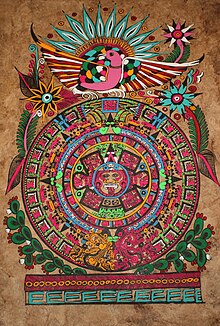
아즈텍 족의 태양 돌은 아마테 인쇄물이다.
아즈텍 문명의 태양 돌은 한때 치올크의 달력과 같은 것으로 여겨졌으나, 지금은 아즈텍 종교 계급이 "만달라"와 유사한 방식으로 전 우주를 상징하는 것으로 여겨지고 있다.
돌의 가장 초기 해석은 달력의 용도와 관련이 있다. 보석이 발굴된 지 2년 후인 1792년, 멕시코의 인류 학자 안토니오 드 레온 y가마는 그 돌을 기초로 아즈텍 달력에 관한 논문을 썼다[27]. 상형 문자의 원 중 일부는 그 달의 날들을 나타내는 상형 문자이다[28]. OllinGlyph에 포함된 4개의 상징들은 Mexica가 지구가 통과했다고 믿었던 4개의 과거 태양들을 나타낸다[29].
이 돌의 또 다른 면은 종교적인 의미이다. 한가지 이론은 돌의 중앙에 있는 얼굴은 태양의 아즈텍 신인 토나티오를 상징한다는 것이다. 이것이 바로 이 돌이 "태양의 돌 "로 알려지게 된 이유입니다. 리차드 타운젠드는 다른 이론을 제안하면서 돌의 중심에 있는 인물은 멕시카 창조 신화에 등장하는 멕시카의 대지 신인 틀랄테쿠틀리를 상징한다고 주장했다[28]. 멕시코 시티의 국립 인류학 박물관에 있는 것들과 같은 현대의 고고학자들은 그것이 점성술이나 천문학적인 참고 자료라기보다는 주로 의식용 세면대나 의식용 제단으로 사용되었을 가능성이 높다고 믿는다[30].
그러나 이 돌의 또 다른 특징은 지리적으로 중요하다는 것이다. 이 네개의 점은 지구의 네 모서리 또는 그 중에서 가장 중요한 점과 관련이 있을 수 있다. 내부의 원은 시간뿐만 아니라 공간도 표현할 수 있습니다[31].
마지막으로, 그 돌에는 정치적인 면이 있다. 그것은 테노치티틀란을 세계의 중심으로, 따라서 권위의 중심으로 보여 주기 위한 것일지도 모른다[32]. 타운젠드는 이 아이디어에 대해 주장하면서, 이전의 4개 태양 중에 1개의 플린트(Tecpatl), 1개의 비(Atl), 7개의 원숭이(Ozomahtli)가 멕시코 국가에 역사적으로 중요한 문제를 나타낸다고 주장했다. 예를 들어, 그는 7마리의 원숭이가 테노치티틀란 내에서 집단을 숭배하는 중요한 날을 상징한다고 추측한다. 그의 주장은 이 작품에 Mexica의 통치자 MoctezumaII의 이름이 있다는 것으로 더욱 뒷받침된다. 이러한 요소들은 신화와 우주에서의 국가의 정통성보다는 역사적으로 스톤의 우상화를 이루었다[33].
기독교[편집]
월터 판케가 지휘하는 습지 예배당 실험 장소의 원형 창문
만다라를 연상시키는 형태들이 기독교에 널리 퍼져 있습니다:켈트 십자가;묵주;광배;오쿨리;가시 나무;장미 창문;로시 크로스;그리고 샤르트르 대성당의 바닥에 있는 드로운. 드로멘은 외부 세계에서 신이 발견된 안쪽 신성한 중심으로 이동하는 여행을 의미한다[34].
웨스트민스터 사원의 그것을 포함한 코스모 폴리탄 포장지는 13세기 이탈리아의 기하학적인 만다라 형태의 모자이크 디자인이다. 웨스트민스터 사원의 거대한 포장 도로는 신성하고 우주적인 기하학적 구조를 영국 군주들의 대관식의 본거지로 여겨진다[35].
비슷하게, 힐데가르드 폰 빈겐의 많은 환영들은 만다라뿐만 아니라 기독교의 헤르메티즘, 기독교의 연금술, 로시크루시아 주의 그림들로도 사용될 수 있다.
연금술사, 수학자, 점성가인 존 디는 그가 시길룸 데이 신의 봉인이라고 부르는 기하학적 상징을 개발했는데, 이는 초기 형태의 클라비쿠라 살로모니스 혹은 솔로몬의 열쇠에서 유래한 아르찬 겔의 이름을 통합한 보편적인 기하학적 질서를 보여 주었다.
신의 봉인;디에 의해 구성된 신비한 헵타의 서사 시적 상징
침례 교도 존 성당에 있는 17세기 초 대리석 조각 상인 '층 기념비비'는 서양 장묘 법에서 만달라를 만들기 위해
연금술을 흡수한 기독교의 도상학적 상징성의 드문 예이다.
■ 페르시아 미술의 만달라스[편집]
페르시아의 이슬람 이론에서, 우리들 각각은 신의 한 부분입니다. 우리는 태양 광선처럼 우리의 근원으로부터 분리되어 왔고, 우리는 항상 우리의 마음 속에 사랑의 근원인 신성한 빛이 있다는 것을 기억할 필요가 있습니다. 이 빛은 항상 우리에게 성장하고 우리의 근원으로 돌아가는 올바른 길을 보여 준다[citation needed].
따라서, 태양을 상징하는 페르시아의 샴시 모티브에는 신의 상징 혹은 에너지원인 센터가 있다. 이 작은 원은 중심은 같지만 크기는 다른 많은 다른 원 또는 다각형으로 둘러싸여 있습니다. 이 원들은 모든 신의 창조물을 상징하는 태양의 빛이다. 모든 생명체는 신에게 도달하는 경향이 있기 때문에, 삶의 목적은 몇몇 언급에서 순수한 사랑으로 언급된 에너지의 근원에 도달하는 것이다. 우리들 중 몇몇은 우리들의 기원에 더 가까운 반면, 우리들 중 몇몇은 그것에 도달하기 위한 긴 여정을 가지고 있다. 샴세처럼, 어떤 원들은 더 작고, 따라서 중심에 더 가깝다[citation needed].
샤메쉬의 모티브는 Safavid시절 이란에서 널리 적용되었다. 사파비드는 이란의 예술, 건축, 점성술, 철학, 철학에서 가장 중요한 통치 왕조 중 하나였다. Shamseh모티프의 특별한 예는 Isfahan에 있는 SheikLotfollah사원의 천장을 타일로 장식한 것이다. 동판에 그려진 페르시아의 '샴시'문양. 페르시에서는 손으로 그림을 그리는 것과 그림을 그리는 것을 "Meenakari"라고 부른다[citation needed].
■ 서양의 심리학적 해석[편집]
예술 치료사이자 정신 건강 상담사인 수잔 F에 따르면 핀쳐씨, 우리는 만다라를 현대 서구의 사고 방식으로 다시 도입한 것은 스위스의 분석 심리학자 칼 구스타프 융 덕분입니다. 정 씨는 자신의 예술 작품을 통해 무의식을 개척하면서 자연스럽게 원의 모티브가 나타나는 것을 관찰했다. 그 서클 그림은 그 당시 그의 내면을 반영하고 있었다. 인도의 철학적인 글에 익숙한 정 장관은 "만다라"라는 단어를 사용해 자신과 그의 환자들이 그린 서클 그림들을 묘사했다. 그의 자서전에서 정 씨는 이렇게 썼다.
나는 매일 아침 수첩에 작은 원형 그림을 그렸는데, 그것은 당시의 나의 내면과 일치하는 것 같았다. 만다라의 실체를 차차 깨달았다....자아, 인격의 총체, 모든 것이 조화롭게 된다면 말이다.
—CarlJung, Memories, Dreams, Reflections, 페이지 195–196.
정 씨는 만다라를 만들고 싶은 충동이 개인적으로 강렬한 성장을 하는 순간에 나타난다는 것을 인식했다. 그들의 외모는 심각한 재조정 과정이 정신에서 진행 중이라는 것을 보여 준다. 그 과정의 결과는 더 복잡하고 더 잘 통합된 성격이다.
Mandala는 보수 주의자들을 위해, 또는 이전의 주문을 복구하기 위해 시간을 절약한다. 하지만 그것은 또한 아직 존재하지도 않고 새롭고 독특한 것에 표현과 형식을 부여하는 창조적인 목적을 제공한다. 이 프로세스는 상승 완화 곡선을 사용하는 것으로, 상승 완화 곡선은 위로 올라가는 동시에 같은 지점으로 반복해서 복귀합니다.
—Jungian분석가 Marie-LouisvonFranz, C.G.Jung:사람과 그의 상징, 페이지 225
만다라를 만드는 것은 내적인 삶을 안정시키고, 통합하고, 순서를 바꾸는 것을 도와 줍니다[36].
미국의 예술 치료사 조안 켈로그는 정 씨의 연구를 계속하면서 MARI카드 테스트라는 진단 도구를 개발했습니다[37].
심리학자 데이비드 폰타나에 따르면, 그것의 상징적인 본성은 "무의식의 더 깊은 단계에 점진적으로 접근할 수 있게 해 주고, 궁극적으로 명상가들이 우주가 다양한 형태로 생성되는 궁극적인 통합과 함께 일체감의 신비한 느낌을 경험하도록 도와 준다"고 한다[38].
■ 고고학에 있어서[편집]
최근 몇년간 동양 사상과 만다라의 전통의 역사를 재정의할 수 있는 가장 강렬한 고고학적 발견 중 하나는 구글 어스의 이미지를 가지고 만든 마니푸르 계곡에서 5마리의 거대한 만다라를 발견한 것이다. 마니푸르의 수도인 임팔의 서부 논에 위치한 마클랑 지리학은 아마도 진흙으로만 지어진 세계 최대의 만다라일 것이다. 이 사이트는 구글 어스 위성 사진을 통해서만 전체 구조를 볼 수 있기 때문에 2013년까지 발견되지 않았다. 지역적으로 비후 루콘이라고 알려진 논 전체가 같은 해에 마니푸르 정부에 의해 보호되고 역사적인 기념물과 부지로 발표되었다. 현장은 24°48'N과 93°49'E의 GPS좌표를 가진 Kangla로부터 12km상공 거리에 위치해 있다. 총 면적은 약 224,161.45 평방 미터이다. 이 정사각형 만다라에는 좌우에 있는 비슷하지만 작은 사각형'문'이 각각 보호되는 4개의 이와 유사한 직사각형'문'이 있다. 사각형 안에는 8개의 꽃잎 모양의 꽃이 있고, 최근에는 지역 주민들에 의해 마클랑'스타 요새'라고 불리는, 중앙에는 약 5만 836.66 평방 미터의 총 면적을 차지하고 있다. 마니푸르 계곡에서 다른 다섯마리의 거대한 만다라들도 구글 어스로 발견되었다. 다섯마리의 거대한 만다라, 즉 세크마팔만, 파르주 쌍둥이 만달라, 상골만 만달라가 이릴 강의 서쪽 기슭에 위치해 있습니다[39].
건축에서[편집]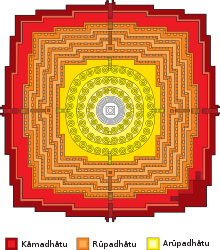
만다라의 형태를 취한 보로부두르 평면도
불교 건축은 종종 만다라를 청사진으로 사용하거나 사찰과 탑을 포함한 불교 구조물을 설계할 계획을 세웠다. 만다라의 건축의 대표적인 예는 인도네시아 중부 자바에 있는 9세기 보로부두르입니다. 계단식 피라미드를 형성한 테라스에 놓인 작은 탑들에 둘러 쌓여 있는 커다란 탑으로, 위에서 보면 거대한 탄트리 불교 만다라의 형태를 취하고 있으며, 동시에 불교의 우주론과 정신의 본질을 표현하고 있다[40]. 만다라의 계획을 가지고 있는 같은 시기의 다른 사원들로는 스우, 플라오산, 프람바난이 있다. 캄보디아, 태국, 미얀마에서도 비슷한 만다라 디자인을 볼 수 있다.
과학에서[편집]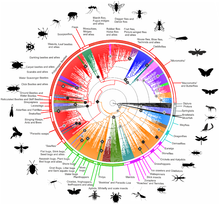
헥사포다의 계통 발생 나무(곤충과 그들의 다리가 6개인 친척). 그러한 나무들은 상형 문자라고 불려 왔다[41].
원형 도표는 특히 계통 발생적 관계를 그래픽으로 표현할 때 자주 사용된다.
진화 나무는 종종 나무의 주변에 나타난 종의 이미지와 함께 원형 나무에 편리하게 보여지는 수많은 종들을 포함한다. 이러한 다이어그램은 phylogeneticmandala라고 불려 왔다[41].
현대에 있어서.[편집]
패션 디자이너 만달리 멘드릴라는 2015년 11월 상하이의 중국 미술관에서 전시된 평화 실크와 친환경 직물 잉크로 만든 만달라는 대화형 아트 설치물을 디자인했다. 이 드레스의 무늬는 8개의 꽃잎을 가진 연꽃 모양을 한 골로카 얀트라 만다라에 바탕을 두고 있습니다. 방문객들은 조각 드레스에 소원을 비는 초대를 받았는데, 이 드레스는 인도로 가져가 진짜 살아 있는 소원 나무에게 제공될 것이다[42][43].
갤러리[편집]
메트로폴리탄 미술관을 통해 중국 메루 산과 비단 태피스트리를 가진 우주 만다라
금강 반다리아, 비단 태피스트리, 메트로폴리탄 미술관을 통해 중국
4개의 T자 모양의 문과 중심 원을 가진, 바깥 사각형을 보여 주는 스리랑카의 대각선 그림
비슈누 만달라(전통적으로 네팔에서 발견됨)
19세기 나로파 전통의 티벳 만다라로 그려진, 금강 역사는 두개의 교차된 빨간 삼각형들의 중앙에 서 있다, 루빈 박물관
19세기, 루빈 박물관의 중심에 있는 프라자나파라미타 여신과 함께 그려진 부타네세 약사불 만달라
여섯개의 차크라바틴의 만달라
금강 반다라히 만달라
제인 우주론도 있고 문자도 있어요
칼 융의 환자가 그린 만다라
마하비라의 자인 사진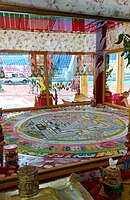
특별한 유리 전시관에 있는 칼라차크라 만다라. 불교 순례자들은 그 정자를 시계 방향으로 세번 건넌다. 부랴트 공화국, 2019년 7월 16일
참고 항목[편집]![]() 종교 포탈
종교 포탈![]() 예술의 문
예술의 문
건축 도면
점성술 기호
바바카라–순환적 존재의 상징적 표현
차크라–인도 종교의 난해한 전통 속에 있는 하위의 신체 심리 에너지 중심지
다르마차카라–종교적 상징
형태 상수–최면술, 환각 그리고 의식의 상태를 바꾸는 동안 반복적으로 관찰되는 몇가지 기하학적 패턴 중 하나입니다.
가나 차크라–탄트릭 어셈블리 또는 연회
위대한 존재의 사슬-모든 물질과 생명체의 계층적 구조
Hilya
비탈리즘-분해된 과학적 가설
마법진
레이 선
기독교의 첫번째 상징인 만들리언
Namkha
종교 예술
스리얀트라
얀트라스리 라마차크라
Sigil
매직 스퀘어
생명의 나무(카발라)
아이슬란드의 신비한 별헬름의
Vegvísir
Veve
포스 필드(픽션)
참조[편집]
^ "mandala". Merriam–Webster Online Dictionary. 2008. Retrieved 2008-11-19.
^ Tanabe, Willa Jane (2001). "Japanese Mandalas: Representations of Sacred Geography". Japanese Journal of Religious Studies. 28 (1/2): 186–188. JSTOR 30233691.
^ 키퍼, 불교 만달라–신성한 기하학과 예술
^ www.sbctc.edu (adapted). "Module 4: The Artistic Principles" (PDF). Saylor.org. Retrieved 2 April 2012.
^ 칸나 마두, 얀트라: 우주 통일의 탄트리 상징. 템즈 강과 허드슨, 1979년, 12페이지.
^ 칸나, 마두, 얀트라: 우주 통일의 탄트리 상징. 템즈 강과 허드슨, 1979년, 페이지 12-22
^ 싱, 교수님. MahendraPrasad(2011). 인도 정치 사상: 테마와 생각하는 사람들. PearsonEducationIndia. ISO8131758516 페이지 11-13.
^ Dellios, Rosita (2003-01-01). "Mandala: from sacred origins to sovereign affairs in traditional Southeast Asia". Bond University Australia. Retrieved 2011-12-11.
^ John Ankerberg, John Weldon (1996), Encyclopedia of New Age Beliefs: The New Age Movement, p. 343, ISBN 9781565071605
^ "Vajrabhairava Mandala". The Metropolitan Museum of Art. The Metropolitan Museum of Art. Retrieved 19 November 2017.
^ Watt, James C.Y. (1997). When Silk was Gold: Central Asian and Chinese Textiles. New York: The Metropolitan Museum of Art. p. 95.
^ Mipham(2000)페이지 65,80
^ "Cosmological Mandala with Mount Meru". The Metropolitan Museum of Art. The Metropolitan Museum of Art. Retrieved 19 November 2017.
^ Watt, James C.Y. (2010). The World of Khubilai Khan: Chinese Art in the Yuan Dynasty. New York: Yale University Press. p. 247. Retrieved 19 November 2017.
^ "A Monograph on a Vajrayogini Thanka Painting". 13 August 2003. Archived from the original on 13 August 2003.
^ Camphausen, Rufus C. "Charnel- and Cremation Grounds". Retrieved 10 October 2016.
^ "Archived copy". Archived from the original on 2006-03-03. Retrieved 2006-11-25.
^위로 이동ab: "Mandala". Retrieved 10 October 2016.
^ "The Mandala in Tibet". Retrieved 10 October 2016.
^ "Mandala". Retrieved 10 October 2016.
^ 1975년 Pembaerne:페이지 164
^ Kvaerne, Per (1975). On the Concept of Sahaja in Indian Buddhist Tantric Literature. (NB: article first published in Temenos XI (1975): pp.88-135). Cited in: Williams, Jane (2005). Buddhism: Critical Concepts in Religious Studies, Volume 6. Routledge. ISBN 0-415-33226-5, ISBN 978-0-415-33226-2. ISBN 9780415332323. Retrieved April 16, 2010.
^ "What Is a Mandala?". studybuddhism.com.
^ "Preliminary practice (ngöndro) overview". Retrieved 10 October2016.
^ 인류학의 선구자-마야 만달라
^ 마야의 만달라스
^ 안토니오 데 레온 이 가마 데스크리프콘 히스트리카스 크로놀로지카 데 라스 두스 피데라스 레온 이가마
^위로 이동ab: K. 밀스, W.B. 테일러&S.L. 그레이엄, 식민지 라틴 아메리카:문헌 역사,'다섯개의 에라스의 아즈텍 스톤', 23페이지
^ Townsend, Casey (1979). State and Cosmos in the Art of Tenochtitlan. Washington, DC: Dumbarton Oaks.
^ GettyMuseum,"아즈텍 달력 돌 "2018은 2018년 8월 22일에 방문했습니다.
^ K. 밀스, W.B. 테일러&S.L. 그레이엄, 식민지 라틴 아메리카:문헌 역사,'다섯개의 에라스의 아즈텍 스톤', 페이지 23,25
^ K. 밀스, W.B. 테일러&S.L. 그레이엄, 식민지 라틴 아메리카:문헌 역사,'다섯개의 에라스의 아즈텍 스톤', 페이지 25-6
^ Townsend, Richard Fraser (1997-01-01). State and cosmos in the art of Tenochtitlan. Dumbarton Oaks, Trustees for Harvard University. ISBN 9780884020837. OCLC 912811300.
^ 데이비드 폰타나:"Mandalas와 함께 명상", 11,54,118페이지 참조
^ "Cosmati Pavement - Video Library". www.westminster-abbey.org.
^ 수잔 F를 참조하십시오. Fincher:Mandalas 만들기: Insight, Healing및 Self-Expression, 페이지 1-18
^ Kellogg, Joan. (1984). Mandala : path of beauty. Lightfoot, VA: MARI. ISBN 0-9631949-1-7. OCLC 30430100.
^ 데이비드 폰타나를 만나 보십시오. Mandalas와 함께 메타 데이터, 페이지 10페이지
^ 왕암, 소모르지(2018). 마니푸르와 칼 융의 '자아의 원형'에서 세계에서 가장 큰 만다라스(Manipur), 25-33페이지. 에드, 네스콜라 Dr.K.NimaiSingh, Imphal. ISSN235-0336
^ A. Wayman (1981). "Reflections on the Theory of Barabudur as a Mandala". Barabudur History and Significance of a Buddhist Monument. Berkeley: Asian Humanities Press.
^위로 이동ab: Hasegawa, Masami (2017). "Phylogeny mandalas for illustrating the Tree of Life". Molecular Phylogenetics and Evolution. 117: 168–178. doi:10.1016/j.ympev.2016.11.001. PMID 27816710.
^ "China Art Museum in Shanghai - Forms of Devotion". Retrieved 10 October 2016.
^ "Haljinu "Mandala of Desires" dnevno posjećuje čak 30 000 ljudi!".
원천[편집]
Brauen, M.(1997). 런던 티베트 불교 세린디아 프레스의 만달라, 성스러운 원.
버크넬, 로데릭&스튜어트 폭스, 마틴(1986). 트와일라잇 언어: 불교식 명상과 상징 주의의 설명. 커슨 프레스:런던. ISO0-312-82540-4
Cammann, S.(1950). 티벳의 만다라 그림의 기원이 디트로이트의 계간지에 제시되어 있습니다.
Cowen, Painton(2005). 로즈 윈도우, 런던, 뉴욕(수백개의 컬러 삽화와 함께 형태의 진화와 의미에 대한 가장 완벽한 개요를 제공한다).
크로스 맨, 실비, 바루, 장 피에르(1995). 티베트 만다라, 예술과 시간의 수레 바퀴, 코네키, 코네키.
폰타나, 데이비드(2005). 런던에서 던컨 베어드 출판사의 "Mandalas와 합병"
금, 피터(1994). 나바호와 티베트의 신성한 지혜:영혼의 원. ISO-89281-411-X. 버몬트 주 로체스터: 국제 내부 거래소
샹암(2018)의 소모르지입니다. "마니푸르와 칼 융의 자아 원형", neScholar, vol.04,01, ed.
투치, 주세페(1973). 만다라 전이의 이론과 실천 뉴욕의 앨런 허튼 브로드릭, 사무엘 위스너입니다.
비탈리, 로베르토(1990)입니다. 중앙 티베트 런던의 초기 사원들, 세린디아 출판물들.
웨이먼, 알렉스(1973년). 모티랄 바나시다스 불교 탄트라스 델리의 만달라 궁전 상징 주의
추가적인 읽기[편집]
그로텐후이스, 엘리자베스 10세. 일본의 만다라:신성한 지리학의 표현, 호놀룰루: 하와이 대학 출판부
외부 링크[편집]
만다라스 소개
만달라스는 로상삼텐의 달라이 라마 남가일 수도원 전통에 관한 연구
Kossak, S(1998). 신성한 환영:티벳 중심부의 초기 그림들. 뉴욕: 메트로폴리탄 미술관색인 참조)
범주:Mandalas
불교 철학적 개념
불교 미술
불교의 명상
세레모니스
힌두교 철학적 개념
인도의 도상 법
명상
종교적인 물건
종교적 상징
티베트 불교의 관습
티베트 불교 의식 도구
● From 위키영문 https://en.wikipedia.org/wiki/maṇḍala
영문위키 원문
>>>
Mandala
From Wikipedia, the free encyclopedia
Jump to navigationJump to search
For other uses, see Mandala (disambiguation).
Not to be confused with Mancala.
Thangka painting of Manjuvajra mandala
A mandala (emphasis on first syllable; Sanskrit मण्डल, maṇḍala – literally "circle") is a geometric configuration of symbols with a very different application. In various spiritual traditions, mandalas may be employed for focusing attention of practitioners and adepts, as a spiritual guidance tool, for establishing a sacred space and as an aid to meditation and trance induction. In the Eastern religions of Hinduism, Buddhism, Jainism and Shintoism it is used as a map representing deities, or specially in the case of Shintoism, paradises, kami or actual shrines.[1][2]
In New Age, the mandala is a diagram, chart or geometric pattern that represents the cosmos metaphysically or symbolically; a time-microcosm of the universe, but it originally meant to represent wholeness and a model for the organizational structure of life itself, a cosmic diagram that shows the relation to the infinite and the world that extends beyond and within minds and bodies.
Contents
1 Hinduism
1.1 Religious meaning
1.2 Political meaning
2 Buddhism
2.1 Vajrayana
2.1.1 Visualisation of Vajrayana teachings
2.1.1.1 Mount Meru
2.1.1.2 Wisdom and impermanence
2.1.1.3 Five Buddhas
2.1.2 Practice
2.1.3 Offerings
2.2 Shingon Buddhism
2.3 Nichiren Buddhism
2.4 Pure Land Buddhism
3 Mesoamerican civilizations
3.1 Mayan Tzolk'in
3.2 Aztec Sun Stone
4 Christianity
5 Mandalas in Persian art
6 Western psychological interpretations
7 In archaeology
8 In architecture
9 In science
10 In contemporary use
11 Gallery
12 See also
13 References
14 Sources
15 Further reading
16 External links
Hinduism
Mandala of Vishnu
Religious meaning
The basic form of hinduism mandalas is a square with four gates containing a circle with a center point and it is also called a yantra. Each gate is in the general shape of a T.[3] Mandalas often have radial balance.[4]
A yantra is similar to a mandala, usually smaller and using a more limited colour palette. It may be a two- or three-dimensional geometric composition used in sadhanas, puja or meditative rituals, and may incorporate a mantra into its design. It is considered to represent the abode of the deity. Each yantra is unique and calls the deity into the presence of the practitioner through the elaborate symbolic geometric designs. According to one scholar, "Yantras function as revelatory symbols of cosmic truths and as instructional charts of the spiritual aspect of human experience"[5]
Many situate yantras as central focus points for Hindu tantric practice. Yantras are not representations, but are lived, experiential, nondual realities. As Khanna describes:
Despite its cosmic meanings a yantra is a reality lived. Because of the relationship that exists in the Tantras between the outer world (the macrocosm) and man's inner world (the microcosm), every symbol in a yantra is ambivalently resonant in inner–outer synthesis, and is associated with the subtle body and aspects of human consciousness.[6]
Political meaning
Main articles: Mandala (political model), Greater India, and Indosphere
The Rajamandala (or Raja-mandala; circle of states) was formulated by the Indian author Kautilya in his work on politics, the Arthashastra (written between 4th century BCE and 2nd century BCE). It describes circles of friendly and enemy states surrounding the king's state.[7]
In historical, social and political sense, the term "mandala" is also employed to denote traditional Southeast Asian political formations (such as federation of kingdoms or vassalized states). It was adopted by 20th century Western historians from ancient Indian political discourse as a means of avoiding the term 'state' in the conventional sense. Not only did Southeast Asian polities not conform to Chinese and European views of a territorially defined state with fixed borders and a bureaucratic apparatus, but they diverged considerably in the opposite direction: the polity was defined by its centre rather than its boundaries, and it could be composed of numerous other tributary polities without undergoing administrative integration.[8] Empires such as Bagan, Ayutthaya, Champa, Khmer, Srivijaya and Majapahit are known as "mandala" in this sense.
Buddhism
Painted 17th-century Tibetan 'Five Deity Mandala', in the centre is Rakta Yamari (the Red Enemy of Death) embracing his consort Vajra Vetali, in the corners are the Red, Green, White and Yellow Yamaris, Rubin Museum of Art
Sandpainting showing Buddha mandala, which is made as part of the death rituals among Buddhist Newars of Nepal
The term appears in the Rigveda as the name of the sections of the work, and Vedic rituals use mandalas such as the Navagraha mandala to this day.
Vajrayana
Main article: Vajrayana
In Vajrayana Buddhism, mandalas have been developed also into sandpainting. They are also a key part of Anuttarayoga Tantra meditation practices.
Visualisation of Vajrayana teachings
The mandala can be shown to represent in visual form the core essence of the Vajrayana teachings. The mind is "a microcosm representing various divine powers at work in the universe."[9] The mandala represents the nature of the Pure Land, Enlightened mind.
An example of this type of mandala is Vajrabhairava mandala a silk tapestry woven with gilded paper depicting lavish elements like crowns and jewelry, which gives a three-dimensional effect to the piece.[10][11]
Mount Meru
A mandala can also represent the entire universe, which is traditionally depicted with Mount Meru as the axis mundi in the center, surrounded by the continents.[12] One example is the Cosmological Mandala with Mount Meru, a silk tapestry from the Yuan dynasty that serves as a diagram of the Tibetan cosmology, which was given to China from Nepal and Tibet.[13][14]
Wisdom and impermanence
In the mandala, the outer circle of fire usually symbolises wisdom. The ring of eight charnel grounds[15] represents the Buddhist exhortation to be always mindful of death, and the impermanence with which samsara is suffused: "such locations were utilized in order to confront and to realize the transient nature of life".[16] Described elsewhere: "within a flaming rainbow nimbus and encircled by a black ring of dorjes, the major outer ring depicts the eight great charnel grounds, to emphasize the dangerous nature of human life".[17] Inside these rings lie the walls of the mandala palace itself, specifically a place populated by deities and Buddhas.
Five Buddhas
One well-known type of mandala is the mandala of the "Five Buddhas", archetypal Buddha forms embodying various aspects of enlightenment. Such Buddhas are depicted depending on the school of Buddhism, and even the specific purpose of the mandala. A common mandala of this type is that of the Five Wisdom Buddhas (a.k.a. Five Jinas), the Buddhas Vairocana, Aksobhya, Ratnasambhava, Amitabha and Amoghasiddhi. When paired with another mandala depicting the Five Wisdom Kings, this forms the Mandala of the Two Realms.
Practice
Tantric mandala of Vajrayogini
Mandalas are commonly used by tantric Buddhists as an aid to meditation.
The mandala is "a support for the meditating person",[18] something to be repeatedly contemplated to the point of saturation, such that the image of the mandala becomes fully internalised in even the minutest detail and can then be summoned and contemplated at will as a clear and vivid visualized image. With every mandala comes what Tucci calls "its associated liturgy ... contained in texts known as tantras",[19] instructing practitioners on how the mandala should be drawn, built and visualised, and indicating the mantras to be recited during its ritual use.
By visualizing "pure lands", one learns to understand experience itself as pure, and as the abode of enlightenment. The protection that we need, in this view, is from our own minds, as much as from external sources of confusion. In many tantric mandalas, this aspect of separation and protection from the outer samsaric world is depicted by "the four outer circles: the purifying fire of wisdom, the vajra circle, the circle with the eight tombs, the lotus circle".[18] The ring of vajras forms a connected fence-like arrangement running around the perimeter of the outer mandala circle.[20]
As a meditation on impermanence (a central teaching of Buddhism), after days or weeks of creating the intricate pattern of a sand mandala, the sand is brushed together into a pile and spilled into a body of running water to spread the blessings of the mandala.
Kværne[21] in his extended discussion of sahaja, discusses the relationship of sadhana interiority and exteriority in relation to mandala thus:
...external ritual and internal sadhana form an indistinguishable whole, and this unity finds its most pregnant expression in the form of the mandala, the sacred enclosure consisting of concentric squares and circles drawn on the ground and representing that adamant plane of being on which the aspirant to Buddha hood wishes to establish himself. The unfolding of the tantric ritual depends on the mandala; and where a material mandala is not employed, the adept proceeds to construct one mentally in the course of his meditation."[22]
Offerings
Chenrezigsand mandala created at the House of Commons of the United Kingdom on the occasion of the Dalai Lama's visit in May 2008
A "mandala offering"[23] in Tibetan Buddhism is a symbolic offering of the entire universe. Every intricate detail of these mandalas is fixed in the tradition and has specific symbolic meanings, often on more than one level.
Whereas the above mandala represents the pure surroundings of a Buddha, this mandala represents the universe. This type of mandala is used for the mandala-offerings, during which one symbolically offers the universe to the Buddhas or to one's teacher. Within Vajrayana practice, 100,000 of these mandala offerings (to create merit) can be part of the preliminary practices before a student even begins actual tantric practices.[24] This mandala is generally structured according to the model of the universe as taught in a Buddhist classic text the Abhidharma-kośa, with Mount Meru at the centre, surrounded by the continents, oceans and mountains, etc.
Shingon Buddhism
One Japanese branch of Mahayana Buddhism—Shingon Buddhism—makes frequent use of mandalas in its rituals as well, though the actual mandalas differ. When Shingon's founder, Kukai, returned from his training in China, he brought back two mandalas that became central to Shingon ritual: the Mandala of the Womb Realm and the Mandala of the Diamond Realm.
These two mandalas are engaged in the abhiseka initiation rituals for new Shingon students, more commonly known as the Kechien Kanjō (結縁灌頂). A common feature of this ritual is to blindfold the new initiate and to have them throw a flower upon either mandala. Where the flower lands assists in the determination of which tutelary deity the initiate should follow.
Sand mandalas, as found in Tibetan Buddhism, are not practiced in Shingon Buddhism.
Nichiren Buddhism
The mandala in Nichiren Buddhism is called a moji-mandala (文字曼陀羅) and is a paper hanging scroll or wooden tablet whose inscription consists of Chinese characters and medieval-Sanskrit script representing elements of the Buddha's enlightenment, protective Buddhist deities, and certain Buddhist concepts. Called the Gohonzon, it was originally inscribed by Nichiren, the founder of this branch of Japanese Buddhism, during the late 13th Century. The Gohonzon is the primary object of veneration in some Nichiren schools and the only one in others, which consider it to be the supreme object of worship as the embodiment of the supreme Dharma and Nichiren's inner enlightenment. The seven characters Namu Myōhō Renge Kyō, considered to be the name of the supreme Dharma, as well as the invocation that believers chant, are written down the center of all Nichiren-sect Gohonzons, whose appearance may otherwise vary depending on the particular school and other factors.
Pure Land Buddhism
Mandalas have sometimes been used in Pure Land Buddhism to graphically represent Pure Lands, based on descriptions found in the Larger Sutra and the Contemplation Sutra. The most famous mandala in Japan is the Taima mandala, dated to about 763 CE. The Taima mandala is based on the Contemplation Sutra, but other similar mandalas have been made subsequently. Unlike mandalas used in Vajrayana Buddhism, it is not used as an object of meditation or for esoteric ritual. Instead, it provides a visual representation of the Pure Land texts, and is used as a teaching aid.[citation needed]
Also in Jodo Shinshu Buddhism, Shinran and his descendant, Rennyo, sought a way to create easily accessible objects of reverence for the lower-classes of Japanese society. Shinran designed a mandala using a hanging scroll, and the words of the nembutsu (南無阿彌陀佛) written vertically. This style of mandala is still used by some Jodo Shinshu Buddhists in home altars, or butsudan.
Mesoamerican civilizations
Mayan Tzolk'in
Mayan Tzolk'in wheel from 498 AD.
One of several parallels between Eastern and Mesoamerican cultures, the Mayan civilization tended to present calendars in a form similar to a mandala.[25] It is similar in form and function to the Kalachakra (Wheel of Time) sand paintings of Tibetan Buddhists.[26] The tzolk'in wheel has 260 segments, surprising because the Mayans recognized that the calendar year is 365 days long. The inclusion of the specific number 260 could however relate to the 26,000 year cycle of the precession of the equinoxes. If so, this would indicate a remarkable awareness of these great cycles of time by this culture. Ultimately, the symbol was probably used for ritual purposes, and to measure the interval of a number of 9-month intervals like pregnancy, the cultivation time of some crops, and rituals that were performed at a 260-day spacing each year, for example, spring and fall.
This Mayan symbology has even made its way into New Age symbolism as the Dreamspell calendar, developed by José Argüelles. Sometimes described as an authentic Mayan mandala, it is "inspired by" elements of the Tzolk'in wheel of time.
Aztec Sun Stone
The Aztec Sun Stone as an amate print.
The Sun Stone of the Aztec civilization was once believed to be their equivalent of a Tzolk'in calendar, but is now thought to be a ceremonial representation of the entire universe as seen by the Aztec religious class, in some ways resembling “mandala.”
The earliest interpretations of the stone relate to its use as a calendar. In 1792, two years after the stone's unearthing, Mexican anthropologist Antonio de León y Gama wrote a treatise on the Aztec calendar using the stone as its basis.[27] Some of the circles of glyphs are the glyphs for the days of the month.[28] The four symbols included in the Ollin glyph represent the four past suns that the Mexica believed the earth had passed through.[29]
Another aspect of the stone is its religious significance. One theory is that the face at the center of the stone represents Tonatiuh, the Aztec deity of the sun. It is for this reason that the stone became known as the "Sun Stone." Richard Townsend proposed a different theory, claiming that the figure at the center of the stone represents Tlaltecuhtli, the Mexica earth deity who features in Mexica creation myths.[28] Modern archaeologists, such as those at the National Anthropology Museum in Mexico City, believe it is more likely to have been used primarily as a ceremonial basin or ritual altar for gladiatorial sacrifices than as an astrological or astronomical reference.[30]
Yet another characteristic of the stone is its possible geographic significance. The four points may relate to the four corners of the earth or the cardinal points. The inner circles may express space as well as time.[31]
Lastly, there is the political aspect of the stone. It may have been intended to show Tenochtitlan as the center of the world and therefore, as the center of authority.[32] Townsend argues for this idea, claiming that the small glyphs of additional dates amongst the four previous suns—1 Flint (Tecpatl), 1 Rain (Atl), and 7 Monkey (Ozomahtli)—represent matters of historical importance to the Mexica state. He posits, for example, that 7 Monkey represents the significant day for the cult of a community within Tenochtitlan. His claim is further supported by the presence of Mexica ruler Moctezuma II's name on the work. These elements ground the Stone's iconography in history rather than myth and the legitimacy of the state in the cosmos.[33]
Christianity
The round window at the site of the Marsh Chapel Experiment supervised by Walter Pahnke
Forms which are evocative of mandalas are prevalent in Christianity: the Celtic cross; the rosary; the halo; the aureole; oculi; the Crown of Thorns; rose windows; the Rosy Cross; and the dromenon on the floor of Chartres Cathedral. The dromenon represents a journey from the outer world to the inner sacred centre where the Divine is found.[34]
The Cosmati pavements, including that at Westminster Abbey, are geometric mandala-like mosaic designs from thirteenth century Italy. The Great Pavement at Westminster Abbey is believed to embody divine and cosmic geometries as the seat of enthronement of the monarchs of England.[35]
Similarly, many of the Illuminations of Hildegard von Bingen can be used as mandalas, as well as many of the images of esoteric Christianity, as in Christian Hermeticism, Christian Alchemy, and Rosicrucianism.
Alchemist, mathematician and astrologer John Dee developed a geometric symbol which he called the Sigillum Dei 'Seal of God' manifesting a universal geometric order which incorporated the names of the archangels, derived from earlier forms of the clavicula salomonis or key of Solomon.
The Seal of God; a mystic heptagram symbol composed by Dee
The Layer Monument, an early 17th-century marble mural funerary monument at the Church of Saint John the Baptist, Maddermarket, Norwich, is a rare example of Christian iconography absorbing alchemical symbolism to create a mandala in Western funerary art.
Mandalas in Persian art
In Persian Islamic theosophy, each of us is a part of God. We have been separated from our source like the rays of the sun and, we need to always keep in our mind that we have a divine light in us, which is the source of love. This light always shows us the right path to grow and find our way back to our source.[citation needed]
Therefore, in Persian Shamseh motif which symbolizes the sun, there is a center which is the symbol of god or the source of energy. This small circle is surrounded by many other circles or polygons with the same center but in different sizes. These circles are the light rays of the sun which symbolize every god's creature. Every creature tends to reach God, so the purpose of life is to reach back the source of energy which is mentioned as pure love in some references. Some of us are closer to our origin, while some of us have a long journey to reach it. As in Shamseh, some circles are smaller, therefore, closer to the center.[citation needed]
Shamseh motif was wildly applied during Safavid time in Iran. Safavid was one of the most important ruling dynasties of Iran in art, architecture, astrology, philosophy, and theosophy. An extraordinary example of Shamseh motif would be the tiling of the ceiling of Sheik Lotfollah mosque in Isfahan. Persian "Shamseh" motif painted on a copper plate. The art of hand painting and enameling is called "Meenakari" in Farsi.[citation needed]
Western psychological interpretations
According to art therapist and mental health counselor Susanne F. Fincher, we owe the re-introduction of mandalas into modern Western thought to Carl Gustav Jung, the Swiss analytical psychologist. In his pioneering exploration of the unconscious through his own art making, Jung observed the motif of the circle spontaneously appearing. The circle drawings reflected his inner state at that moment. Familiarity with the philosophical writings of India prompted Jung to adopt the word "mandala" to describe these circle drawings he and his patients made. In his autobiography, Jung wrote:
I sketched every morning in a notebook a small circular drawing, ... which seemed to correspond to my inner situation at the time. ... Only gradually did I discover what the mandala really is: ... the Self, the wholeness of the personality, which if all goes well is harmonious.
— Carl Jung, Memories, Dreams, Reflections, pp. 195–196.
Jung recognized that the urge to make mandalas emerges during moments of intense personal growth. Their appearance indicates a profound re-balancing process is underway in the psyche. The result of the process is a more complex and better integrated personality.
The mandala serves a conservative purpose—namely, to restore a previously existing order. But it also serves the creative purpose of giving expression and form to something that does not yet exist, something new and unique. ... The process is that of the ascending spiral, which grows upward while simultaneously returning again and again to the same point.
— Jungian analyst Marie-Louise von Franz, C. G. Jung: Man and His Symbols, p. 225
Creating mandalas helps stabilize, integrate, and re-order inner life.[36]
American art therapist Joan Kellogg continued in Jung's work and created a diagnostic tool – MARI card test.[37]
According to the psychologist David Fontana, its symbolic nature can help one "to access progressively deeper levels of the unconscious, ultimately assisting the meditator to experience a mystical sense of oneness with the ultimate unity from which the cosmos in all its manifold forms arises."[38]
In archaeology
One of the most intense archaeological discoveries in recent years that could redefine the history of eastern thought and tradition of mandala is the discovery of five giant mandalas in the valley of Manipur made with Google Earth imagery. Located in the paddy field in the west of Imphal, the capital of Manipur, the Maklang geoglyph is perhaps the world's largest mandala built entirely of mud. The site wasn't discovered until 2013 as its whole structure could only be visible via Google Earth satellite imagery. The whole paddy field, locally known as Bihu Loukon, is now protected and announced as historical monument and site by the government of Manipur in the same year. The site is situated 12 km aerial distance from Kangla with the GPS coordinates of 24° 48' N and 93° 49' E. It covers a total area of around 224,161.45 square meters. This square mandala has four similar protruding rectangular ‘gates’ in the cardinal directions guarded each by similar but smaller rectangular ‘gates’ on the left and right. Within the square there is an eight petalled flower or rayed-star, recently called as Maklang ‘Star fort’ by the locals, in the centre covering a total area of around 50,836.66 square meters. The discovery of other five giant mandalas in the valley of Manipur is also made with Google Earth. The five giant mandalas, viz., Sekmai mandala, Heikakmapal mandala, Phurju twin mandalas and Sangolmang mandala are located on the western bank of the Iril River.[39]
In architecture
Borobudur ground plan taking the form of a Mandala
Buddhist architecture often applied mandala as the blueprint or plan to design Buddhist structures, including temple complex and stupas. A notable example of mandala in architecture is the 9th century Borobudur in Central Java, Indonesia. It is built as a large stupa surrounded by smaller ones arranged on terraces formed as a stepped pyramid, and when viewed from above, takes the form of a giant tantric Buddhist mandala, simultaneously representing the Buddhist cosmology and the nature of mind.[40] Other temples from the same period that also have mandala plans include Sewu, Plaosan and Prambanan. Similar mandala designs are also observable in Cambodia, Thailand and Myanmar.
In science
Phylogenetic tree of Hexapoda (insects and their six-legged relatives). Such trees have been called phylogenetic mandalas.[41]
Circular diagrams are often used in phylogenetics, especially for the graphical representation of phylogenetic relationships. Evolutionary trees often encompass numerous species that are conveniently shown on a circular tree, with images of the species shown on the periphery of a tree. Such diagrams have been called phylogenetic mandalas.[41]
In contemporary use
Fashion designer Mandali Mendrilla designed an interactive art installation called Mandala of Desires (Blue Lotus Wish Tree) made in peace silk and eco friendly textile ink, displayed at the China Art Museum in Shanghai in November 2015. The pattern of the dress was based on the Goloka Yantra mandala, shaped as a lotus with eight petals. Visitors were invited to place a wish on the sculpture dress, which will be taken to India and offered to a genuine living Wish Tree.[42][43]
Gallery
Cosmological mandala with Mount Meru, silk tapestry, China via The Metropolitan Museum of Art
Vajrabhairava mandala, silk tapestry, China via The Metropolitan Museum of Art
A diagramic drawing of the Sri Yantra, showing the outside square, with four T-shaped gates, and the central circle
Vishnu Mandala(Traditionally found in Nepal)
Painted 19th century Tibetan mandala of the Naropa tradition, Vajrayogini stands in the center of two crossed red triangles, Rubin Museum of Art
Painted Bhutanese Medicine Buddha mandala with the goddess Prajnaparamita in center, 19th century, Rubin Museum of Art
Mandala of the Six Chakravartins
Vajravarahi mandala
Jain cosmological diagrams and text.
Mandala painted by a patient of Carl Jung
Jain picture of Mahavira
Kalachakra mandala in a special glass pavilion. Buddhist pilgrims bypass the pavilion in a clockwise direction three times.Buryatiya, July 16, 2019
See also
P religion world.svgReligion portalNuvola apps package graphics.pngArts portal
Architectural drawing
Astrological symbols
Bhavacakra – A symbolic representation of cyclic existence
Chakra – Subtle body psychic-energy centers in the esoteric traditions of Indian religions
Dharmachakra – Religious symbol
Form constant – One of several geometric patterns which are recurringly observed during hypnagogia, hallucinations and altered states of consciousness.
Ganachakra – Tantric assemblies or feasts
Great chain of being – Hierarchical structure of all matter and life
Hilya
Vitalism – Discredited scientific hypothesis
Magic Circle
Ley Line
Mandylion, the first icon in Christianity
Namkha
Religious art
Sri Yantra
Yantra
Sriramachakra
Sigil
Magic square
Tree of life (Kabbalah)
Icelandic magical staves
Helm of Awe
Vegvísir
Veve
Force field (fiction)
References
"mandala". Merriam–Webster Online Dictionary. 2008. Retrieved 2008-11-19.
Tanabe, Willa Jane (2001). "Japanese Mandalas: Representations of Sacred Geography". Japanese Journal of Religious Studies. 28 (1/2): 186–188. JSTOR 30233691.
Kheper,The Buddhist Mandala – Sacred Geometry and Art
www.sbctc.edu (adapted). "Module 4: The Artistic Principles" (PDF). Saylor.org. Retrieved 2 April 2012.
Khanna Madhu, Yantra: The Tantric Symbol of Cosmic Unity. Thames and Hudson, 1979, p. 12.
Khanna, Madhu, Yantra: The Tantric Symbol of Cosmic Unity. Thames and Hudson, 1979, pp. 12-22
Singh, Prof. Mahendra Prasad (2011). Indian Political Thought: Themes and Thinkers. Pearson Education India. ISBN 8131758516. pp. 11-13.
Dellios, Rosita (2003-01-01). "Mandala: from sacred origins to sovereign affairs in traditional Southeast Asia". Bond University Australia. Retrieved 2011-12-11.
John Ankerberg, John Weldon (1996), Encyclopedia of New Age Beliefs: The New Age Movement, p. 343, ISBN 9781565071605
"Vajrabhairava Mandala". The Metropolitan Museum of Art. The Metropolitan Museum of Art. Retrieved 19 November 2017.
Watt, James C.Y. (1997). When Silk was Gold: Central Asian and Chinese Textiles. New York: The Metropolitan Museum of Art. p. 95.
Mipham (2000) pp. 65,80
"Cosmological Mandala with Mount Meru". The Metropolitan Museum of Art. The Metropolitan Museum of Art. Retrieved 19 November 2017.
Watt, James C.Y. (2010). The World of Khubilai Khan: Chinese Art in the Yuan Dynasty. New York: Yale University Press. p. 247. Retrieved 19 November 2017.
"A Monograph on a Vajrayogini Thanka Painting". 13 August 2003. Archived from the original on 13 August 2003.
Camphausen, Rufus C. "Charnel- and Cremation Grounds". Retrieved 10 October 2016.
"Archived copy". Archived from the original on 2006-03-03. Retrieved 2006-11-25.
"Mandala". Retrieved 10 October 2016.
"The Mandala in Tibet". Retrieved 10 October 2016.
"Mandala". Retrieved 10 October 2016.
Per Kvaerne 1975: p. 164
Kvaerne, Per (1975). On the Concept of Sahaja in Indian Buddhist Tantric Literature. (NB: article first published in Temenos XI (1975): pp.88-135). Cited in: Williams, Jane (2005). Buddhism: Critical Concepts in Religious Studies, Volume 6. Routledge. ISBN 0-415-33226-5, ISBN 978-0-415-33226-2. ISBN 9780415332323. Retrieved April 16, 2010.
"What Is a Mandala?". studybuddhism.com.
"Preliminary practice (ngöndro) overview". Retrieved 10 October 2016.
Frontiers of Anthropology — The Mayan Mandala
Mandalas of the Maya: Celestial Waters and the Auroral Plumes of Tláloc
Antonio de León y Gama: Descripción histórica y cronológica de las dos piedras León y Gama
K. Mills, W. B. Taylor & S. L. Graham (eds), Colonial Latin America: A Documentary History, 'The Aztec Stone of the Five Eras', p. 23
Townsend, Casey (1979). State and Cosmos in the Art of Tenochtitlan. Washington, DC: Dumbarton Oaks.
Getty Museum, "Aztec Calendar Stone" getty.edu, accessed 22 August 2018
K. Mills, W. B. Taylor & S. L. Graham (eds), Colonial Latin America: A Documentary History, 'The Aztec Stone of the Five Eras', pp. 23, 25
K. Mills, W. B. Taylor & S. L. Graham (eds), Colonial Latin America: A Documentary History, 'The Aztec Stone of the Five Eras', pp. 25-6
Townsend, Richard Fraser (1997-01-01). State and cosmos in the art of Tenochtitlan. Dumbarton Oaks, Trustees for Harvard University. ISBN 9780884020837. OCLC 912811300.
See David Fontana: "Meditating with Mandalas", p. 11, 54, 118
"Cosmati Pavement - Video Library". www.westminster-abbey.org.
see Susanne F. Fincher: Creating Mandalas: For Insight, Healing, and Self-Expression, pp. 1 - 18
Kellogg, Joan. (1984). Mandala : path of beauty. Lightfoot, VA: MARI. ISBN 0-9631949-1-7. OCLC 30430100.
See David Fontana: Meditating with Mandalas, p. 10
Wangam, Somorjit (2018). World's Largest Mandalas from Manipur and Carl Jung's Archetype of the Self, p. 25-33. NeScholar, ed. Dr. R.K.Nimai Singh ,Imphal. ISSN 2350-0336.
A. Wayman (1981). "Reflections on the Theory of Barabudur as a Mandala". Barabudur History and Significance of a Buddhist Monument. Berkeley: Asian Humanities Press.
Hasegawa, Masami (2017). "Phylogeny mandalas for illustrating the Tree of Life". Molecular Phylogenetics and Evolution. 117: 168–178. doi:10.1016/j.ympev.2016.11.001. PMID 27816710.
"China Art Museum in Shanghai - Forms of Devotion". Retrieved 10 October 2016.
"Haljinu "Mandala of Desires" dnevno posjećuje čak 30 000 ljudi!".
Sources
Brauen, M. (1997). The Mandala, Sacred circle in Tibetan Buddhism Serindia Press, London.
Bucknell, Roderick & Stuart-Fox, Martin (1986). The Twilight Language: Explorations in Buddhist Meditation and Symbolism. Curzon Press: London. ISBN 0-312-82540-4
Cammann, S. (1950). Suggested Origin of the Tibetan Mandala Paintings The Art Quarterly, Vol. 8, Detroit.
Cowen, Painton (2005). The Rose Window, London and New York, (offers the most complete overview of the evolution and meaning of the form, accompanied by hundreds of colour illustrations.)
Crossman, Sylvie and Barou, Jean-Pierre (1995). Tibetan Mandala, Art & Practice The Wheel of Time, Konecky and Konecky.
Fontana, David (2005). "Meditating with Mandalas", Duncan Baird Publishers, London.
Gold, Peter (1994). Navajo & Tibetan sacred wisdom: the circle of the spirit. ISBN 0-89281-411-X. Rochester, Vermont: Inner Traditions International.
Mipham, Sakyong Jamgön (2002) 2000 Seminary Transcripts Book 1 Vajradhatu Publications ISBN 1-55055-002-0
Somorjit, Wangam (2018). "World's Largest Mandalas from Manipur and Carl Jung's Archetype of the Self", neScholar, vol.04, Issue 01, ed.Dr. R.K. Nimai Singh ISSN 2350-0336
Tucci, Giuseppe (1973). The Theory and Practice of the Mandala trans. Alan Houghton Brodrick, New York, Samuel Weisner.
Vitali, Roberto (1990). Early Temples of Central Tibet London, Serindia Publications.
Wayman, Alex (1973). "Symbolism of the Mandala Palace" in The Buddhist Tantras Delhi, Motilal Banarsidass.
Further reading
Grotenhuis, Elizabeth Ten (1999). Japanese mandalas: representations of sacred geography, Honolulu: University of Hawai'i Press
External links
This article's use of external links may not follow Wikipedia's policies or guidelines. Please improve this article by removing excessive or inappropriate external links, and converting useful links where appropriate into footnote references. (October 2016) (Learn how and when to remove this template message)
Wikimedia Commons has media related to Mandalas.
Introduction to Mandalas
Mandalas in the Tradition of the Dalai Lamas' Namgyal Monastery by Losang Samten
Kossak, S (1998). Sacred visions : early paintings from central Tibet. New York: The Metropolitan Museum of Art. (see index)
vte
Tibetan Buddhism
vte
Topics in Buddhism
Authority control Edit this at Wikidata
GND: 4125841-1NDL: 00567436
Categories: MandalasBuddhist philosophical conceptsBuddhist artBuddhist meditationCeremoniesHindu philosophical conceptsIndian iconographyMeditationReligious objectsReligious symbolsTibetan Buddhist practices
>>>
>>>
● From 대만불광사전
만다라
【曼荼羅】 p4400-下≫
梵語 maṇḍala,
西藏語 dkyil-ḥkhor.
又作
曼陀羅․
曼咤羅․
漫荼羅․
蔓陀羅․
曼拏扌羅․
滿荼邏․
滿拏囉.
意譯壇․
壇場․
輪圓具足․
聚集.
印度修密法時,
爲防止魔衆侵入,
而劃圓形․
方形之區域,
或建立土壇,
有時亦於其上畫佛․
菩薩像,
事畢像廢 ; 故一般以區劃圓形或方形之地域,
稱爲曼荼羅,
認爲區內充滿諸佛與菩薩,
故亦稱爲聚集․
輪圓具足.
在律中,
亦有爲避不淨,
而在種種場合作曼荼羅者.
xxxxxx據大日經疏卷四載,
曼荼羅有種種意義 : 自輪圓具足之意而言,
諸尊如輪般環繞於普門之大日如來四周,
協助大日,
使衆生趣入普門 ; 自發生之意而言,
能養育佛種,
而生佛樹王(佛果) ; 又由梵語 maṇḍa 乃精製牛乳爲醍醐之意,
故曼荼羅表佛果之醇淨融妙,
有極無比味․
無過上味之意.
但後世密敎認爲,
曼荼羅主要是聚集之意,
亦卽諸佛․
菩薩․
聖者所居處之地.
印度築土壇,
係於其上圖出諸尊,
事後,
復破壞之,
但我國及日本則專用紙帛圖出諸尊.
日本東密,
係指於金剛界圖出金剛界曼荼羅,
於胎藏界圖出胎藏界曼荼羅等之兩部曼荼羅(兩界曼荼羅).
在臺密,
則以蘇悉地法用雜曼荼羅.
又兩部曼荼羅之圖樣因經及儀軌不同而有異,
現流行之圖示曼荼羅,
稱爲現圖曼荼羅.
曼荼羅有四種,
稱爲四種曼荼羅,
簡稱四曼.
依金剛頂經之說,
卽 : (一)諸尊具足相好容貌之圖畫,
稱爲大曼荼羅(尊形曼荼羅),
相當於金剛界曼荼羅之成身會.
(二)諸尊之三昧耶,
卽表示本誓之器杖․
刀劍等之持物,
以圖示或於手結印契,
稱爲三昧耶曼荼羅,
相當於三昧耶會.
(三)諸尊之種子及眞言,
或書種子之梵字於諸尊本位,
或以法身之三摩地以及一切經論之文義等,
稱爲法曼荼羅(種子曼荼羅),
相當於微細會.
(四)將諸尊之威儀事業鑄造成像,
稱爲羯磨曼荼羅,
相當於供養會.
此四種曼荼羅,
又各含有三種曼荼羅,
卽 : (1)都會(都門․
普門)曼荼羅,
諸尊聚集一起,
如以大日如來爲中心之兩部曼荼羅.
(2)部會曼荼羅,
部分諸尊,
如佛部之佛頂曼荼羅,
蓮華部之十一面觀音曼荼羅等.
(3)別尊(一門)曼荼羅,
以一尊爲中心之釋迦曼荼羅․
如意輪曼荼羅等.
依大日經之說法,
可歸納於三種祕密身,
卽 : (一)字,
乃法曼荼羅.
(二)印,
乃三昧耶曼荼羅.
(三)形,
乃大曼荼羅.
此三身各具足威儀事業,
稱爲羯磨曼荼羅.
四曼荼羅雖圓滿具足萬德,
然總歸於一而超越相對,
此謂體大曼荼羅 ; 具備衆相之差別,
稱爲相大曼荼羅 ; 具足三密之業用,
稱爲用大曼荼羅.
又四曼荼羅攝盡一切存在之相狀,
故對六大體大․
三密用大,
稱爲四曼相大.
此外,
尙有三種四曼荼羅之說,
卽 : (一)就過去世而言,
集中於法身大日如來說法席之聖衆,
爲自性會四曼.
(二)就未來世而言,
影像及書畫,
爲世間住持四曼.
(三)就現在世而言,
瑜伽行者爲行者修成四曼.
至於大智印․
三昧耶智印․
法智印․
羯磨智印等四智印(四印)與四曼之異同,
乃是體同而名異 ; 或謂四曼乃通於有情․
非情者,
而四印則只限於有情者 ; 或謂四曼對本有之體而得名,
四印乃對修生之用而得名.
金剛界曼荼羅(金剛界,
梵語 vajra-dhātu),
表示大日之智法身.
又作
果曼荼羅․
智曼荼羅․
西曼荼羅․
月輪曼荼羅.
此係根據金剛頂經等所作之圖.
日本東密使用自九會形成之九會曼荼羅 ; 臺密則使用成身一會之曼荼羅.西南(五)四印會
(六)一印會
(七)理趣會(薩埵會) (普賢會)北(四)供養會(大供養會)
(一)羯磨會(成身會)(根本會)
(八)降三世羯磨會(降三世會)
(三)微細會(羯磨會)
(二)三昧耶會(羯磨會)
(九)降三世三 昧耶會東 九會曼荼羅乃印度隨宜之說,
如左圖所示(括弧內爲別稱).
現圖曼荼羅計收一四六一尊.
羯磨會以下之六會,
相當於金剛頂經金剛界品所說之金剛界大曼荼羅․
陀羅尼曼荼羅․
微細金剛曼荼羅․
一切如來廣大供養羯磨曼荼羅․
四印曼荼羅․
一印曼荼羅等六曼荼羅.
其餘三會之所據則無定說.
金剛界曼荼羅原爲成身一會,
而九會則似是集合九種曼荼羅者.
其圖相之義,
金剛係表示菩提之智慧體,
堅固不壞,
且有摧毁一切之功能.
圖相排列順序係以羯磨會爲首,
最下爲降三世三昧耶會,
此卽表示如來敎導衆生,
起化他之作用,
係「從果向因」之下轉門,
至羯磨會以下之供養會乃表示各個四曼.
四印會表示四曼相互不離,
一印會則表示四曼乃爲絶對之一實相而容納於六大.
以上六會卽三輪身中自性輪身之曼荼羅.
理趣會爲正法輪身金剛薩埵之曼荼羅,
表示欲․
觸․
愛․
慢之相.
降三世羯磨會與降三世三昧耶會,
則表示由於以上二輪身,
對難以敎化之衆生,
顯示忿怒的敎令輪身之降三世明王之容貌,
而使之折伏.
此外,
降三世三昧耶會以下,
逆向羯磨會,
係表示菩薩之修行順位,
係「從因向果」之上轉門.
降三世三昧耶會則象徵以大悲之弓箭,
射伏無明之怨敵,
發起上求菩提下化衆生之誓願,
乃至羯磨會係表示完成威儀具足之大日如來(卽羯磨身).
或對前圖依照<七><八><九><五><四><三><六><一><二>之順序,
有種種解釋,
如謂此乃從自證至化他,
又從化他還歸自證之「自證化他折伏攝受不二」之曼荼羅.
九會之中,
表示羯磨會(成身會)圖相者,
卽於中央畫一大圓輪,
其中現出五月輪,
且於中央月輪中安置大日及四波羅蜜菩薩,
而於四方月輪安置四佛及四親近等十六大菩薩.
其他,
復畫八供養(內四供養․
外四供養)․
四攝․
賢劫千佛․
外金剛部二十天․
四大神等.
金剛界曼荼羅分爲佛部(理智具足覺道圓滿)․
金剛部(智)․
寶部(福德)․
蓮華部(理)․
羯磨部(化他作用)等五部.
大日․
阿閦․
寶生․
阿彌陀․
不空成就等五佛,
爲其各部之部主 ; 而大日以外之四佛則自大日四親近之四波羅蜜菩薩出生,
故此四菩薩稱爲部母.
東北外金剛部院南文殊院地藏院釋迦院除蓋障院觀音院遍知院金剛手院中臺八葉院持明院虛空藏院蘇悉地院西 胎藏界曼荼羅(胎藏界,
梵語 garbha-dhātu),
乃表示大日之理法身.
又作
因曼荼羅․
理曼荼羅․
東曼荼羅․
大悲曼荼羅.
佛之大悲,
若以胎藏爲譬喩,
卽從此胎藏而生曼荼羅之意,
此乃根據大日經之繪圖而來.
其圖形不一,
如經疏曼荼羅․
阿闍梨所傳曼荼羅․
胎藏舊圖樣․
胎藏圖像․
現圖曼荼羅,
而部院之廢立及所列之諸尊皆有差異.
傳說爲日僧惠果所作之現圖曼荼羅立有十三大院,
然於日僧空海之祕藏記中,
省略四大護院,
而僅有十二大院.
其他尙有省略蘇悉地院,
而爲十一大院者.
日本現行之現圖曼荼羅卽屬於十二大院,
其配列如下圖,
計容納四一四尊.
圖相之意,
表示開顯衆生本具之因德,
卽等於果德之蓮花,
亦卽菩提心之佛種由大悲萬行之母胎(卽胎藏)養育,
直至佛果之意.
從佛菩提自證之德,
示現八葉中胎大日之身,
從大日之德,
示現第一重乃至第四重之諸尊,
此皆象徵大日之德的一部分.
其中,
中臺八葉院之圖相 : 大日位於八葉(八花瓣)蓮花中央之花臺,
東方安置一葉寶幢,
南方安置開敷華王,
西方爲無量壽,
北方爲天鼓雷音,
東南方爲普賢,
西南方爲文殊,
西北方爲觀世音,
東北方則爲彌勒.
以上,
大日表示法界體性智,
四佛表示四智,
四菩薩表示四行(菩提․
福德․
智慧․
羯磨).
胎藏界曼荼羅分爲佛部․
金剛部․
蓮華部等三部.
在衆生心中則表示粗妄執․
細妄執․
極細妄執等三妄執實相之大定․
大智․
大悲等三德.
中臺院及其東西等六院,
相當於佛部,
北方之觀音․
地藏等二院相當於蓮華部,
南方之金剛手․
除蓋障等二院相當於金剛部,
外金剛部院攝屬於三部,
而通稱爲金剛部.
於臺密,
除兩部大日如來以外,
其餘諸尊而爲中尊者之曼荼羅(卽金剛․
胎藏兩界曼荼羅以外之曼荼羅)稱爲雜曼荼羅,
又稱作諸尊曼荼羅․
別尊曼荼羅.
有如來․
佛頂․
諸經․
觀音․
菩薩․
忿怒․
天等分別.
胎藏界曼荼羅之諸尊,
在本位普遍聚集,
稱爲都會壇曼荼羅․
普門曼荼羅 ; 對此,
以藥師․
彌陀․
觀音等諸尊爲中心所建之曼荼羅,
則稱都外別壇․
別尊曼荼羅․
一門曼荼羅.
修尊勝法時所畫者,
稱爲尊勝曼荼羅.
以不動明王爲本尊之曼荼羅,
稱爲不動曼荼羅.
將彌陀․
觀音通種子之「紇利俱」字放置於開敷蓮華中之中臺八葉,
稱爲九字曼荼羅.
此外,
畫法華經說經會之聖衆,
稱爲經法曼荼羅.
畫釋迦三尊及傳俱舍論之諸祖者,
稱爲俱舍曼荼羅.
修法之時,
僅以觀想觀諸尊之形像,
稱爲道場觀曼荼羅.
至於觀想自身爲曼荼羅,
而在四肢五體上布列曼荼羅之諸尊,
則稱支分生曼荼羅.
支分生曼荼羅中,
以胎藏界之中臺八葉院配於頭部,
第一重之內眷屬配於咽喉及心臟,
第二重之諸大菩薩配於臍以下之部位,
稱爲三重流現曼荼羅.
地․
水․
火․
風․
空等五輪配於膝․
腹․
胸․
面․
頂,
稱爲五輪成身曼荼羅.
此外,
金剛界之九會則配於肢體.
灌頂之時,
敷於壇上行者投花得佛所用者,
稱爲敷曼荼羅.
至於一般把曼荼羅作爲禮拜供養之對象,
稱爲曼荼羅供,
略稱曼供,
於諸堂建築落成時之落慶供養多修此曼荼羅.
描畫彌陀之淨土及彌勒之兜率天等相狀,
稱爲淨土曼荼羅,
或兜率曼荼羅,
惟此應稱爲變相.
又圖示法華經敎說內容,
稱爲法華變相及法華曼荼羅.
然於密敎修法華經時,
則另有法華曼荼羅.
又建立曼荼羅,
爲弟子傳授灌頂之傳法阿闍梨,
稱爲曼荼羅阿闍梨.
[大日經卷一具緣品․
有部毘奈耶雜事卷十三․
五祕密儀軌](參閱「變」6912)
● From 丁福保 - 佛學大辭典 : Ding Fubao's Dictionary of Buddhist Studies
曼陀羅
【植物】 Mandārava,
又曰漫陀羅。
花名。
譯作圓華、
白團華、
適意華、
悅意華等。
阿育王經七曰:
「漫陀羅,
翻圓華。
」
法華光宅疏一曰:
「曼陀羅華者,
譯為小白團華。
摩訶曼陀羅華者,
譯為大白團華。
」法華玄贊二曰:
「曼陀羅華者,
此云適意,
見者心悅故。
」
慧苑音義上曰:
「曼陀羅華,
此云悅意華,
又曰雜色華,
亦云柔軟華,
亦云天妙華。
」
案曼陀羅為一年生草,
莖直上,
高四五尺,
葉作卵形,
常有缺刻。
夏日開大紫花,
有漏斗形之合瓣花冠,
邊緣五裂,
實為裂果,
面生多剌,
性有毒,
以其葉雜煙草中同吸。
能止咳嗽,
過量則能致死。
本草,
曼陀羅花。
一名風茄兒,
一名山茄子,
生北土。
法華經佛說法,
天雨曼陀羅花,
翻譯名義:
曼陀羅,
此云適意,
又云白華。
【人名】 高僧名。
翻譯名義云:
曼陀羅,
此言弱聲,
亦云弘弱。
扶南國人,
神解超悟,
幽明畢觀,
無憚夷險,
志存弘化,
即曼陀羅仙也。
● From Soothill-Hodous Dictionary of Chinese Buddhist Terms (DDBC version)
曼陀羅
or 曼阤羅; 漫陀羅 mandāra(va) (मन्दार(व)),
the coral-tree; the erythrina indica,
or this tree regarded as one of the five trees of Paradise,
i.e,
Indra's heaven; a white variety of Calotropis gigantea.
Name of a noted monk,
and of one called Mandra.
● From Mahāvyutpatti (bye brag rtog byed)
mandāravaḥ
[Mvyt: 6202]
梵文 (轉寫) / Sanskrit (IAST):
mandāravaḥ
梵文 (天成體) / Sanskrit (Devanāgarī):
मन्दारवः
中文 / Chinese:
曼陀羅
中文 / Chinese:
風伽子花
藏文 (Wylie) / Tibetan (Wylie):
man dā ra ba
藏文 / Tibetan:
མན་དཱ་ར་བ་
● From Korean Dic
만다라
만다라(曼陀羅·曼□羅←Mandala 범)[명사]
1.불교의 본질인 깨달음의 경지,
또는 부처가 실제로 증험한 것을 그림으로 나타낸 것.
2.부처나 보살의 상을 모시고 예배하며 공단하는 단.
● From Kor-Eng Dictionary
만다라
만다라 [曼陀羅·曼茶羅]
『불교』 a mandala; Buddha's picture.
⑤-4400■불광사전
hbfl--05_Ma_0361.TIF
■ '만다라' 관련 기타 참고 사전 통합 검색
다음백과 https://100.daum.net/search/entry?q=만다라
네이버백과 https://terms.naver.com/search.nhn?query=만다라
한국위키 https://ko.wikipedia.org/wiki/만다라
네이버한자 https://hanja.naver.com/search?query=만다라
네이버지식 https://kin.naver.com/search/list.nhn?query=만다라
네이버사전 https://endic.naver.com/search.nhn?sLn=kr&isOnlyViewEE=N&query=만다라
위키영문 https://en.wikipedia.org/wiki/māndāra_;_mandārava
구글 https://www.google.co.kr/?gws_rd=ssl#newwindow=1&q=만다라
네이버 https://search.naver.com/search.naver?where=nexearch&query=만다라
다음 https://search.daum.net/search?w=tot&q=만다라
--- 이하 단어 직접 입력 검색 ---
운허 동국역경원 불교사전 https://abc.dongguk.edu/ebti/c3/sub1.jsp
실용한-영 불교용어사전 https://dic.tvbuddha.org/
불광대사전(佛光大辭典) https://www.fgs.org.tw/fgs_book/fgs_drser.aspx
산스크리트어사전 https://www.sanskrit-lexicon.uni-koeln.de/monier/
티벳어사전 https://nitartha.pythonanywhere.com/index
● [pt op tr] fr
■ 불교사전 링크 및 불교 사전 출처 종합 안내
https://buddhism0077.blogspot.com/2020/04/blog-post_21.html
●● 관련정보 사용페이지
----[‡사용한 다른 페이지]---
https://buddhism007.tistory.com/3366#1647
sfed--불설대승팔대만나라경_K1215_T1168.txt ☞팔대만나라
sfd8--불교경율논코너sp_2561_07.txt ☞◆vqny1647
Lab value 불기2564/04/22/수/19:06
★%★
![]()
| ◈Lab value 불기2564/04/22/수/19:06 |
○ 음악공양, 나무불, 나무법, 나무승 mus0fl--Mireille Mathieu - Moi C'est La Chanson.lrc  ○ 2020_0211_135806_canon_Ab27.jpg 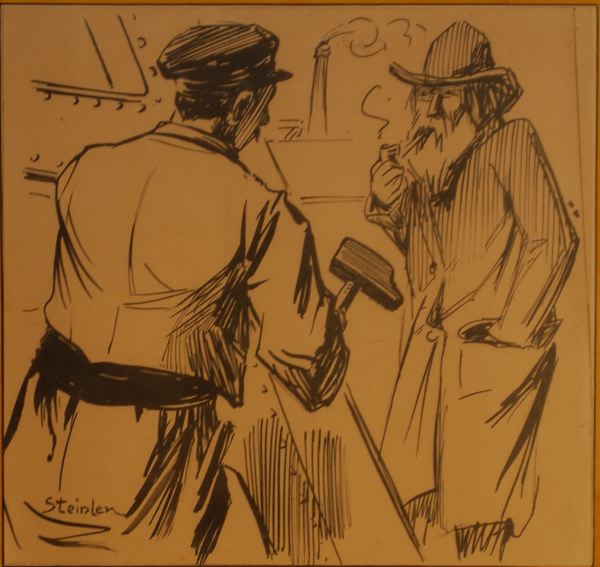 ○ [pt op tr] 예술작품 사진 공양, 나무불, 나무법, 나무승 Theophile Steinlen-conversation-sur-un-chantier ▶더보기 Artist: Theophile Steinlen https://en.wikipedia.org/wiki/Théophile_Steinlen Title : conversation-sur-un-chantier Info Permission & Licensing : Wikiart ● [pt op tr] fr  ○ [pt op tr] 꽃 공양, 나무불, 나무법, 나무승 Starr_080117-1520_Begonia_sp. ▶더보기 English: Begonia sp. (flowering habit). Location: Maui, Walmart Kahului Author Forest & Kim Starr Permission & Licensing : Wikipedia ● [pt op tr] fr ○ [pt op tr] 아름다운 사진 공양, 나무불, 나무법, 나무승 Ssangbongsa_Daeungjeon11-05205 ▶더보기 https://ko.wikipedia.org/wiki/파일:Ssangbongsa_Daeungjeon11-05205.JPG Ssangbongsa 저자 steve46814 Permission & Licensing : Wikipedia ● [pt op tr] fr ♥Wat Chedi Ngam, 치앙마이 태국 ○ 아름다운 풍경사진 공양, 나무불, 나무법, 나무승 With the image 'Google Earth & Map data: Google, DigitalGlobe' ○상세정보=> https://buddhism007.tistory.com/4059 댓글내용 |
| 문서정보 ori https://buddhism0077.blogspot.com/2021/03/mandara_32.html#1460 sfx--dict/만다라.txt sfd8--불교용어dic_2564_04.txt ☞◆vmut1647 불기2564-04-22 θθ |
■ 용어 퀴즈
○ [pt op tr]
★2★
ॐ मणि पद्मे हूँ
○ [pt op tr]
■ 용어퀴즈 다음 설명에 맞는 답을 찾으시오.
■ 용어 퀴즈
4종 자량의 하나. 지난 세상에 복덕을 닦았으므로 지금에 재물이 풍부하고, 좋은 교법을 얻어 수행하여 증과(證果)에 도달할 자량을 삼는 것.
답 후보
● 복덕자량(福德資糧)
본사(本師)
본원력회향(本願力廻向)
본존(本尊)
부루나(富樓那)
부정육(不淨肉)
부휴당집(浮休堂集)
■ 음악
Charles Aznavour - You've Got To Learn (Il Faut S
Michel Sardou - La Maison En Enfer
Pascal Obispo - Assassine 236
Padam - De Travers
Marie Lafort - Marie Douceur, Marie Colere (
JOHNNY HALLYDAY - Quelque Chose De Tennesse
Julien Doré - Figures Imposées
■ 시사, 퀴즈, 유머
뉴스
퀴즈
퀴즈2
유머
■ 한자 파자 넌센스 퀴즈
【 】 ⇄✙➠
일본어글자-발음
중국어글자-발음
■ 영어단어 넌센스퀴즈- 예문 자신상황에 맞게 바꿔 짧은글짓기
■ 번역퀴즈
번역
■ 영-중-일-범-팔-불어 관련-퀴즈
[wiki-bud] Yuanfen
[san-chn] kariṇ 能施
[san-eng] parahyaḥ $ 범어 day before yesterday
[pali-chn] jeṭṭha 逝瑟吒
[pal-eng] abhihata $ 팔리어 pp. of abhihanatistruck; hit.abhiha.ta (pp. of abhiharati), brought to; offered.
[Eng-Ch-Eng] 假合 A provisional combination--the way Buddhists see the human being as composed of four elements and five skandhas (Tib. skabs las byung ba). 〔佛氏雜辨、佛氏真假之辨〕
[Muller-jpn-Eng] 無住處涅槃 ムジュウショネハン nirvana of no-abiding
[Glossary_of_Buddhism-Eng] TEN EVIL ACTS☞
See: Ten Evil Deeds.
[fra-eng] présageant $ 불어 boding
■ 암산퀴즈
118* 863
93408 / 973
■ 다라니퀴즈
자비주 3 번째는?
성관자재보살 명호 81 번째는?
3
수명을 얻게 하기 위함이며,
● 바로기제새바라야 婆盧羯帝爍鉢囉耶<三> va lo ki te ś va rā ya
『불설천수천안관세음보살광대원만무애대비심다라니경』
♣0294-001♧
81
나 소아다미사다라
蘇誐哆尾沙馱囉<八十一>
『성관자재보살일백팔명경』
♣1122-001♧
■ 삼매_게송퀴즈
■ 오늘의 게송
[81일째]
제찰차별불가설 $ 081▲摩覩羅摩覩羅為 一 ● 娑母羅, ○□□□□,種,差,無,種
□□□□□□□, 種種清淨不可說,
差別莊嚴不可說, 無邊色相不可說,
□□□□□□□, 종종청정불가설,
차별장엄불가설, 무변색상불가설,
세계의 차별함을 말할 수 없고
가지가지 청정함도 말할 수 없고
차별한 장엄들도 말할 수 없고
그지없는 빛깔도 말할 수 없고
[82째]
종종간착불가설 $ 082▲娑母羅娑母羅為 一 ● 阿野娑, ○□□□□,種,清,雜,了
□□□□□□□, 種種妙好不可說,
清淨佛土不可說, 雜染世界不可說,
□□□□□□□, 종종묘호불가설,
청정불토불가설, 잡염세계불가설,
가지가지 섞인 것도 말할 수 없고
가지가지 기묘함도 말할 수 없고
청정한 부처 세계 말할 수 없고
물들은 세계들도 말할 수 없고
●K0213_T0828.txt★ ∴≪A무자보협경≫_≪K0213≫_≪T0828≫
●K0071_T0397.txt★ ∴≪A무진의보살경≫_≪K0071≫_≪T0397≫
●K1309_T0469.txt★ ∴≪A문수문경자모품제십사≫_≪K1309≫_≪T0469≫
법수_암기방안
81 서혜부( 사타구니~ thigh 넓적다리주변)
82 오금
3 밥통 【위】
81 서혜부( 사타구니~ thigh 넓적다리주변)
101834
96 
○ 2019_1004_132428_nik_ab36 
○ 2019_1004_142926_can_ct19 
○ 2019_1004_131736_nik_ar38 
○ 2019_1004_165148_can_ct9 
○ 2019_1004_164436_can_ct18 
○ 2019_1004_143652_can_AR35 
○ 2019_1004_164910_can_exc 
○ 2019_1004_153820_can_bw10 
○ 2019_1004_143514_can_ar2 
○ 2019_1004_153000_nik_ar45 
○ 2019_1004_142437_nik_BW25 
○ 2019_1004_133745_can_CT38 
○ 2019_1004_155546_nik_Ab35 
○ 2019_1004_142636_can_BW21 
○ 2019_1004_133453_can_CT27 
○ 2019_1004_133413_can_BW21 
○ 2019_1004_131736_nik_Ab35 
○ 2019_1004_171546_nik_BW17 
○ 2019_1105_165119_nik_Ar28 순천 조계산 송광사
○ 2019_1106_103514_nik_Ab27 화순 영구산 운주사
● [pt op tr] fr

○ 2019_1004_150734_can_Ar26

○ 2019_0405_174420_can_ct20

[관련키워드]
○ 2020_1114_153236_can_Ar28_s12 삼각산 도선사
[업데이트 안내]
중간중간 수정작업시마다 각 사이트별 사정상 일치화 작업을 함께 행하기 힘듭니다.
* 따라서 게시 이후 작업 수정 및 보충은 blogspot 사이트 페이지에서만 반영하기로 합니다.
만일 중간 업데이트된 내용을 열람하고자 할 경우는
blogspot 사이트 주소 링크를 통해 확인해주시기 바랍니다.
작업이 모두 완료되고 일치화가 마쳐지면 본 안내는 제거됩니다.
™善現智福 키워드 연결 페이지
https://buddhism0077.blogspot.com/2020/06/keyword.html
○ [pt op tr]
● 만다라 [문서정보]- 불교용어풀이 키워드
금강승 , Vajrayana,정토 만다라,4종 만다라,금강계 만다라,태장계 만다라,만덕장엄(萬德莊嚴),능생(能生),적집(積集),윤원구족(輪圓具足),단(壇),도장(道場),도량(道場)보리도량(菩提道場) ,maṇḍala 또는 만다라(滿茶羅),만타라(曼陀羅), 만다륵(曼陀勒) , 만나라(曼那羅) , 만다라범(曼陀羅梵) , 천묘(天妙) , 열의(悅意) , 적의(適意) , 잡색(雜色), ,曼茶羅,만다라바,변상도(變相圖),만나라(曼拏羅) , 만나(曼拏) , 만다(曼茶) , 취집(聚集) ,滿茶邏, ,蔓陀囉,曼陀羅,māndāra ; mandārava,man da ra ba,만다라,曼茶羅,maṇḍala,dkyil ’khor,모래 만다라,
[링크용타이틀]
만다라,만나,만나라,만다,만타라,만다륵,만다라바,변상도,취집,능생,적집,윤원구족,단,도장,도량,보리도량,범,천묘,열의,적의,잡색,
■ 본 페이지 ID 정보
DICT--만다라
https://buddhism007.tistory.com/16723
sfx--dict/만다라.txt
sfd8--불교용어dic_2564_04.txt ☞
◆vmut1647
불기2564-04-22
https://blog.naver.com/thebest007/222283894280
https://buddhism0077.blogspot.com/2021/03/mandara_32.html
htmback--만다라_불기2564-04-22-Tis.htm
● [pt op tr] fr
'불교용어연구' 카테고리의 다른 글
| 색계-2 (0) | 2020.04.24 |
|---|---|
| Buddhist cosmology (0) | 2020.04.24 |
| 능파 (0) | 2020.04.21 |
| Glossary_of_Buddhism-Eng (0) | 2020.04.17 |
| 영어위키백과 불교관련용어 (0) | 2020.04.17 |



